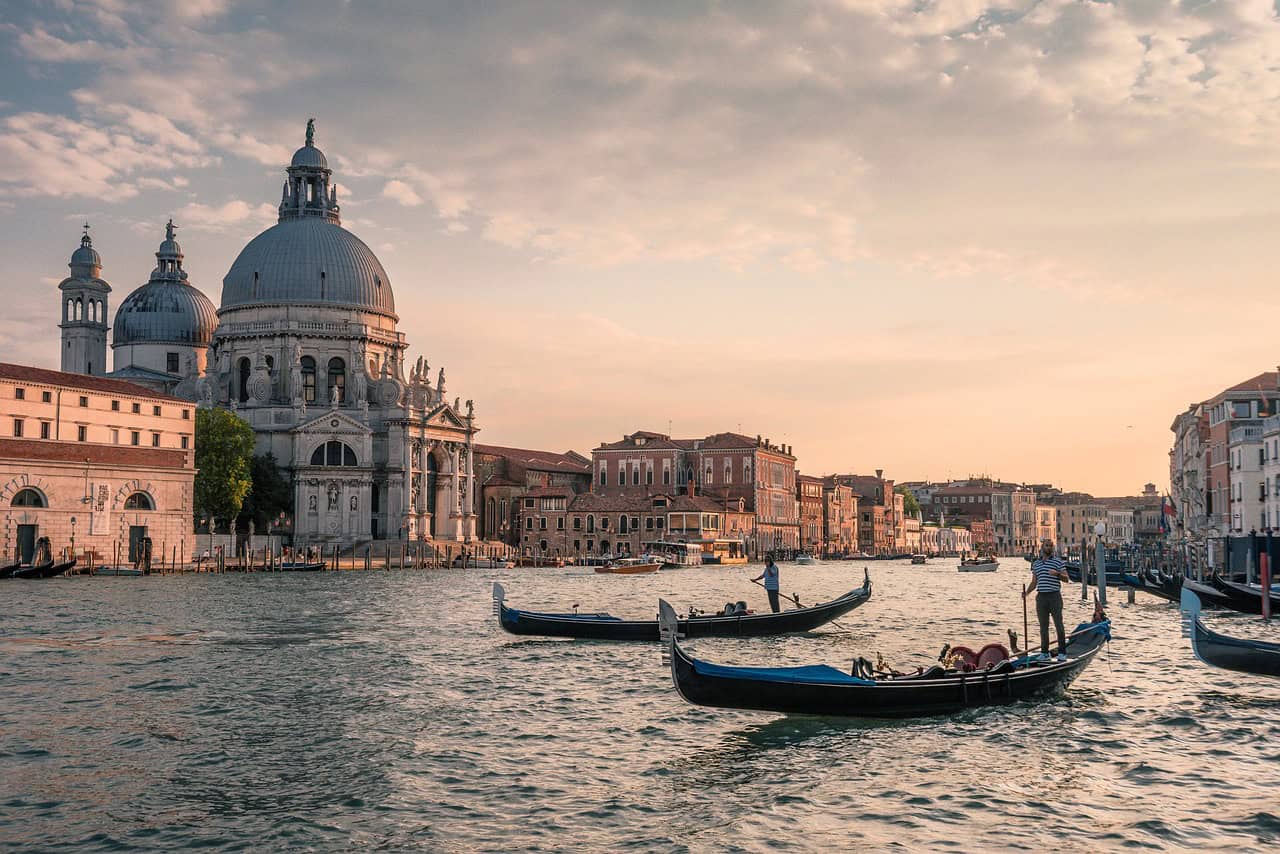Venice is a magical place. From its iconic waterways to the grandiose architecture, the city is filled with incredible beauty and history. Yet, to many across the world, Venice has a reputation for being overly crowded, touristy, or even overrated. Those people didn’t experience Venice the right way. No doubt, there are a lot of tourists and plenty of businesses catering specifically to them, but there is more to Venice than you can experience on a day trip or a cruise stop. Taking the time to experience Venice beyond the crowded tourist hotspots unlocks a greater appreciation of the unique beauty of this place. In this article I’m going to give you the details on how to experience Venice the right way. This is how you should spend 3 days in Venice.

How to Get Here
Thanks to its fame and popularity, Venice is an extremely well connected city. It has its own airport which has connections all across the continent and is also easily accessible via train from major Italian cities such as Milan and Rome.
Fly into Venice
This is the most convenient way to get directly to Venice, but may be more expensive than flying into other cities in Italy. Once you reach Venice Marco Polo Airport there are a couple different ways to reach the city.
Bus
Traveling via bus from the airport to the city will take about 30 minutes and drop you off at Piazzale Roma, the bus station located on the island. To do this take the #5 bus from the airport in the direction of Venezia. Take the bus all the way to the final stop, which takes about 25 minutes.
You can purchase tickets for the bus at the Public Transport ticket office in the Arrivals Hall, or at the ticketing machines. Ticketing machines are located in the baggage claim area near carousels 3 and 5 or at the bus stop. A one-way ticket should cost around €10. Tickets can also be purchased online.
Vaporetto
If you want a more scenic route to the city, consider taking a vaporetto. Vaporettos are the Venetian boat driven public transportation which take visitors directly from the airport to various places around the city. Depending on where in the city you want to go, expect the ride to take 45 minutes to an hour.
Vaporettos leave from the dock at the airport which can be fond by following the light blue “Water Transport” signs in the airport. The boats are operated by Alilaguna and tickets can be purchased in person on the boat, at the ticket machines by baggage claim carousels 3 and 5, or online at the Alilaguna website. A one-way trip to or from the airport costs €15.
There are three lines that depart from the airport: orange, blue, and red. The red line operates seasonally while the others are year-round. The orange line offers the most direct route to the city center, while the other lines also stop on the island of Murano before proceeding to Venice proper. Check out the Alilaguna website for full details on the route options.
Water Taxi
The most luxurious, albeit most expensive, way to reach the city of Venice is via water taxi. A water taxi is a private boat that can take you directly from the airport to wherever you are staying in Venice. These boats are both stylish and comfortable and are also the most direct way to get to your destination.
Prices vary based on season, destination, and time of day, but you should expect to pay anywhere between €100-€200. There are several companies that offer this service. You can find a list of options on the Marco Polo Airport website.
Fly into Milan
This is how I made my way to Venice, as the best priced flight from the US was to Milan. This can be a good way to save money on your flight and it’s pretty convenient to get the train from Milan to Venice. I also highly recommend spending a few days in Milan as it is a great city in its own right, if you’re interested, check out my article on the best things to do in Milan.
To get to Venice from Milan, you’ll first need to navigate your way from the airport to the central train station (Stazione Centrale), where you can catch a train straight to Venice. There are two airports in Milan: Malpensa (MXP) and Linate (LIN). If you’re getting a direct flight from the US to Milan you’ll likely fly into MXP; if you have a connection through another European city you may fly into MXP or LIN. Fortunately it’s fairly easy to reach the central station from either airport.
MXP —> Stazione Centrale
Traveling from MXP to the central station is fairly simple and takes about an hour, depending on the timing of your train. The train is called the Malpensa Express; it runs every 30 minutes and can take you from the airport to the main train station. The ride takes just under an hour.
While you can buy tickets online, I’d recommend purchasing them in person. By doing so, you don’t have to worry about missing your train if your flight gets delayed. Purchasing tickets in person is straightforward, there are clearly marked signs pointing you towards ticketing machines where you can buy your ticket. One tip if you do this is to bring cash if you can as the machines wouldn’t take any of my credit cards. It was likely just an oddity with my cards, but it’s a good reminder to have cash as a safety net.
LIN —> Stazione Centrale
When traveling from LIN you have a few options. Milan’s metro system reaches out to Linate on the M4 line, so you have the option to use the metro to get to the train station. If you take this route you’ll want to catch the M4 metro towards San Babila. Take the train 7 stops to the end of the line at San Babila. From there, switch to the M1 towards Sesto 1 Maggio FS. Take the M1 3 stops to Lima station, from there it’s about a 10 minute walk to Stazione Centrale.
Alternatively, there is a Linate shuttle bus that takes you directly to the central station. A one way ticket for this bus is €7 and can be purchased online, or directly on the bus. Again, I would recommend purchasing in person so that you won’t have to worry about missing your reservation in the event of a delayed flight.
The final option is the Airport Bus Express by Autostrade, which also takes you from LIN to Milano Centrale, tickets cost around €5 and tickets can be bought online.
Milan —> Venice Train
Once you’ve reached the central station check the departure boards to find your train. To reserve your train I recommend booking tickets online ahead of time. There are two companies you can book the train through: Italo Treno and Trenitalia. Italo Treno tends to be a bit cheaper and also offers more routes that don’t require you to change trains, so they would be my recommended company. However, you shouldn’t have any issues if you choose to take Trenitalia.
It’s important to note that the train tickets are significantly (50% or more) cheaper if you book at least a month in advance so you should book as early as you can. Tickets on Italo Treno start at around €13, but prices do vary based on date and time. The ride takes about 2.5 hours. On Trenitalia tickets start around €22, nonstop rides also take around 2.5 hours, but journeys with train changes typically take around 3.5 hours.
When booking your train ticket be sure to choose the correct stations as both cities have multiple stations. For Milan you’ll want to choose Stazione Centrale, the central station, and for Venice you’ll want Santa Lucia, sometimes abbreviated to S. Lucia. Also note that you may need to search for the cities with their Italian spellings which are Milano and Venezia.
Overall, this is a pretty convenient way to get to Venice, especially if it saves you money on your flights. Transportation to and from the airports is fairly straightforward and the train journey from Milan to Venice is not too long. As a bonus, it gives you a look at the beautiful Italian countryside.
Train from another Italian city
Italy’s main cities are all well-connected by train, making it easy to reach Venice from wherever you happen to be in the country. If you’re visiting Venice as part of a larger Italian itinerary then you’ll likely be taking advantage of these train routes. As with the trains from Milan, your best bet for booking a train to Venice is through Italo Treno or Trenitalia. Here’s what you can expect for the journey from a few different cities:
Bologna —> Venice: 1.5 hour train ride, prices starting at €12
Florence —> Venice: 2 1/4 hour train ride, prices starting at €15
Napoli —> Venice: 5.5 hour train ride, prices starting at €36
Rome —> Venice: 4 hour train ride, prices starting at €30
Where to Stay
When choosing where to stay when you visit Venice, the biggest choice is whether or not you stay on the island or the mainland. While you’ll have to pay a bit more for the privilege, I think that it’s an absolute must to stay on the island itself. By staying on the island you’ll be able to experience Venice after the day trippers depart, which brings a whole different feeling to the city.
Neighborhoods
Assuming you choose to stay on the island, you’ll also need to decide which neighborhood to stay in. There are six neighborhoods in Venice, each with differing characteristics, popularity, and price points.
Cannaregio – The location of the historic Jewish Ghetto, this neighborhood is a little bit more off the beaten path, giving it a more local feel and generally lower cost.
Castello – A generally quieter neighborhood that is also off the beaten path but doesn’t have as much of the iconic Venetian style that the city is known for.
Dorsoduro – This neighborhood is home to many famous art collections and is also considered the best neighborhood for nightlife in Venice.
San Marco – This is the most popular and tourist-dense neighborhood in the city. It is home to famous sites such as St. Mark’s Basilica and Doge’s Palace.
San Polo – The other central district in Venice along with San Marco, it can also be crowded and touristy although to a lesser degree than San Marco.
Santa Croce – This neighborhood is sort of the gateway to the city as it houses the bus and train stations. It is a bit cheaper and quieter than the most central neighborhoods.
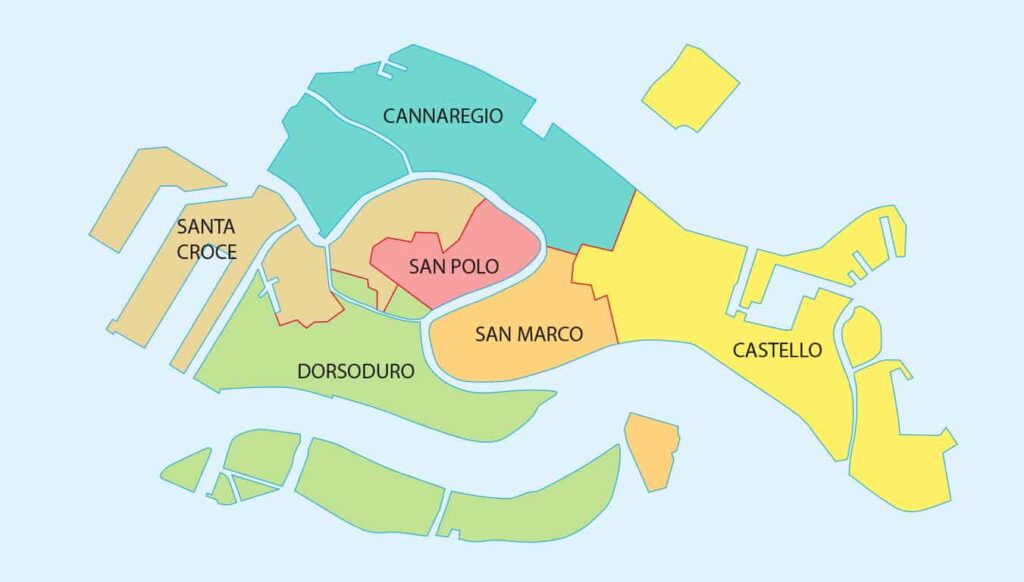
At the end of the day, you can’t really go wrong with any neighborhood. The entire city is both beautiful and walkable. It’s small enough that, regardless of where stay, you can easily get anywhere in the city.
That being said, I do have a favorite neighborhood and that is Cannaregio. In my opinion this is the most beautiful district in the city and since it is also one of the cheapest, it makes for a great place to stay. Despite its vast web of beautiful streets and canals, Cannaregio is noticeably less crowded than other places in the city and my wife and I often found ourselves alone on the streets with no other tourists in sight.
Accommodation
The most important thing to know when choosing your accommodation in Venice is that you should avoid home sharing services such as Airbnb. Venice is one of the cities that has been most adversely affected by the rise in these services and they have contributed to many locals being priced out of their homes. Because of this, for ethical reasons, you should stick to hotels or hostels when you come here.
Fortunately, there are a ton of great hotel options in the city and you should have little problem finding one regardless of which neighborhood you choose to stay in. If you’re staying in Cannaregio you should definitely consider staying at Suites alla Maddalena. It’s an absolutely adorable little hotel located right on a canal. The rooms are clean and comfortable and you’ll likely end up with great views of passing gondolas. My spoiled American self would’ve liked more powerful air conditioning, but the hotel did have some A/C which is a welcome amenity during the hot Italian summer.
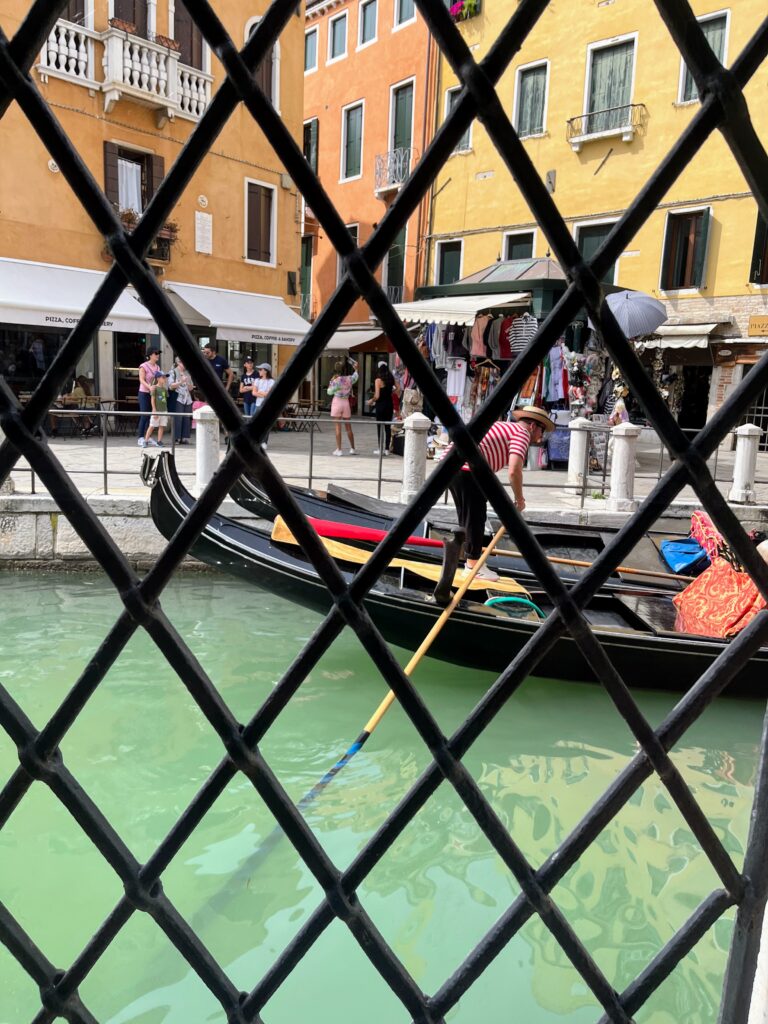
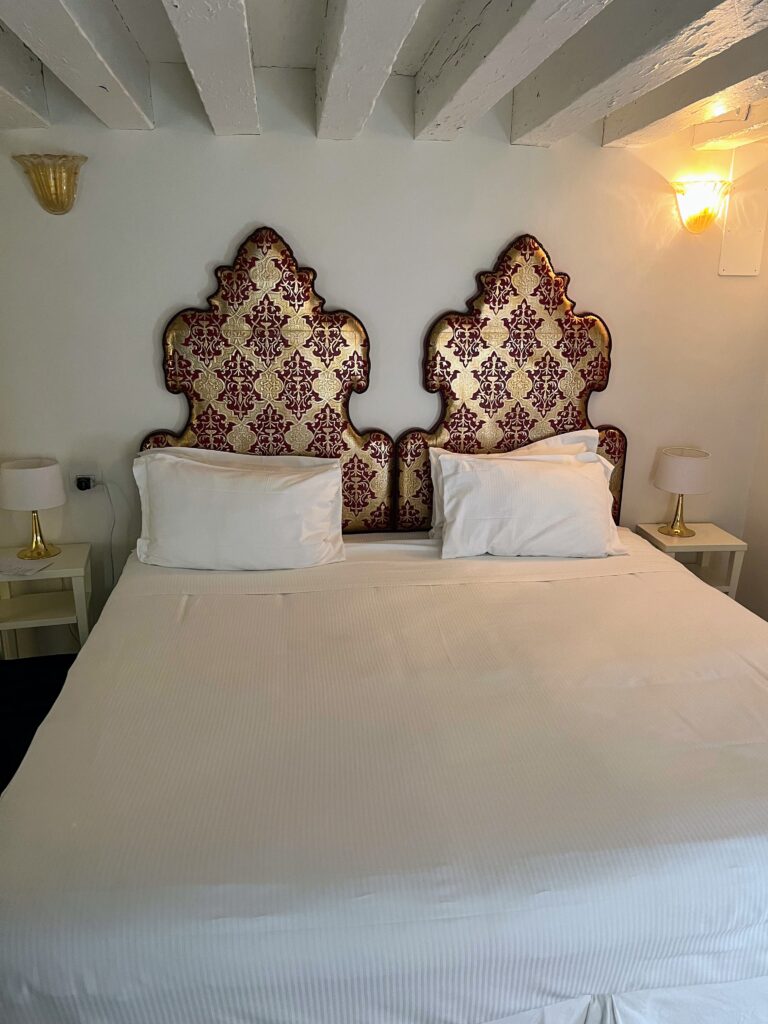
Itinerary
Day 1: Get Lost
The best advice anyone gave me prior to visiting Venice was to “get lost”. Just wandering the streets of Venice is an activity all on its own and, in my opinion, is the best part of visiting the city. On your first of three days in Venice, you can sleep in a bit and enjoy a relaxing day with minimal planning.
9:30am – Breakfast
After giving yourself some deserved rest having just made your way to Venice, you’ll want to start your day with something to eat. As you may expect from an Italian city, there are plenty of options to grab a coffee and a sweet bite for breakfast. Since the plan is to spend a lot of today in the Cannaregio neighborhood, I’d recommend stopping at Torrefazione Cannaregio.
Torrefazione Cannaregio is a wonderful little coffee shop that also serves a wide variety of pastries and other breakfast items. It was actually featured on the TV show Somebody Feed Phil, which is how I found it! There is both indoor seating and canal-side outdoor seating. The coffee and pastries were both excellent, I recommend trying the pistachio croissant.
Note: In Italy, they call croissants “Brioche”
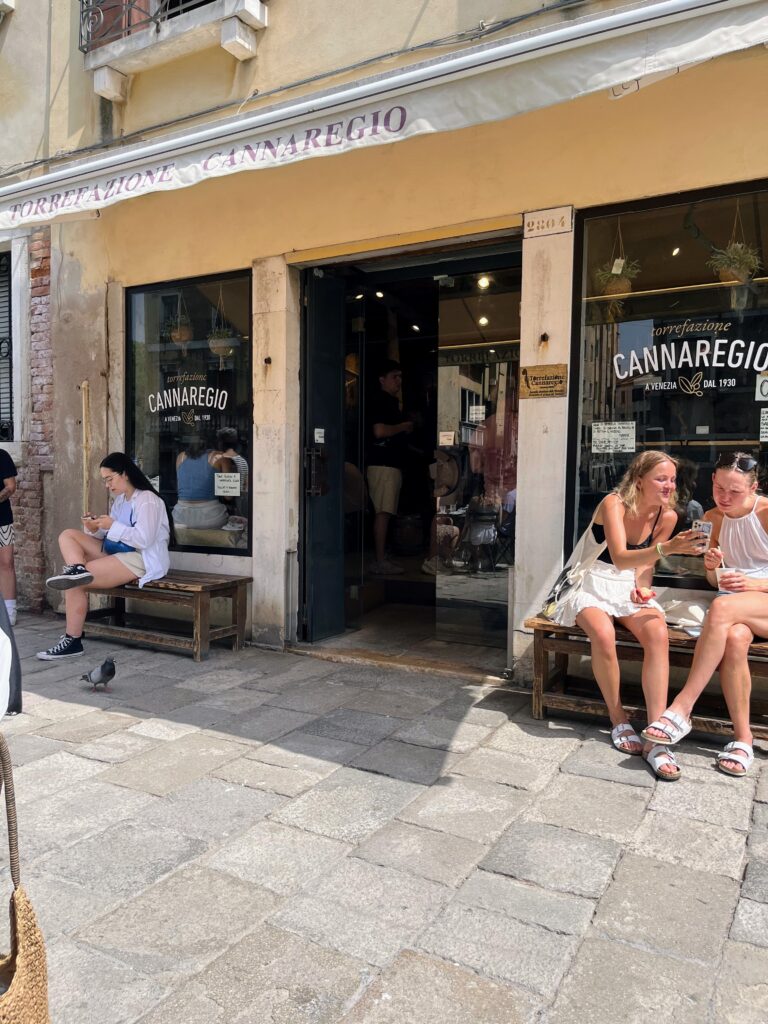

10:15am – Wander Cannaregio
Spend the next chunk of your day just wandering up and down the streets of the Cannaregio neighborhood. I love walking around here because there are a ton of little streets and canals and they’re all incredibly beautiful. I’ll never understand why so many people just stick to the famous sites in the city center and don’t venture out to the rest of the island because this, to me, is where the true beauty of Venice lies.
Take the time to saunter through the winding streets and let yourself appreciate the beauty and history of where you are. Throughout Cannaregio you can find incredible architecture, cute little bridges, and views out onto the lagoon.

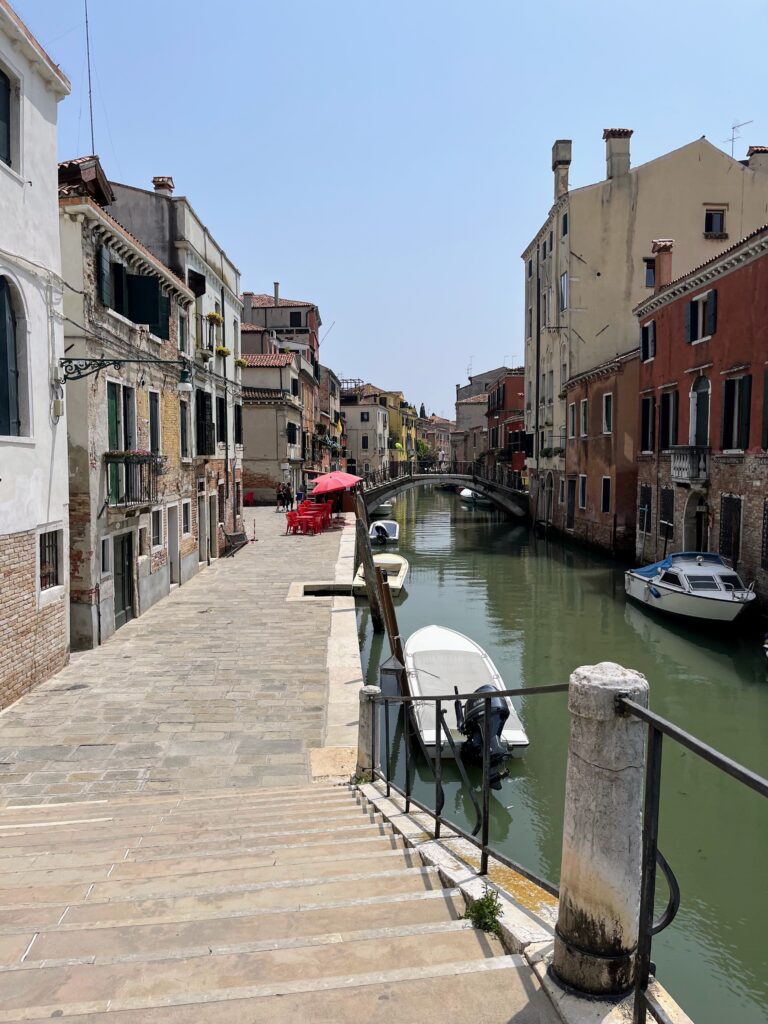
~2pm – Do Some Snacking
All this walking around is going to work up an appetite, so you’ll surely want to grab a bite to eat sometime in the afternoon. If you can manage, I recommend not getting a full meal in preparation for this evening’s activity. Luckily, Venice has great options whether you’re craving something sweet or savory.
One of the culinary highlights of Venice are small bites of food known as cicchetti (chi-ket-ee). These are typically small pieces of bread or polenta topped with some sort of savory food, often seafood. This is great for grabbing a small snack and also gives you the opportunity to try lots of different things.
One of the culinary highlights of Venice are small bites of food known as cicchetti (chi-ket-ee). These are typically small pieces of bread or polenta topped with some sort of savory food, often seafood. This is great for grabbing a small snack and also gives you the opportunity to try lots of different things.
You can find great cicchetti wherever you are in the city, but one place I can recommend is called Estate ai crociferi. This is a ciccheti bar that is actually located inside a hostel, but open to the public. You’ll need to walk through the hostel entrance and through the courtyard to find it. There is seating inside but there is also a quaint courtyard with plenty of seating as well.
Some places that were on my list but I didn’t have a chance to visit are: Osteria al Tajer, Vino Vero, Cantina Vecia Carbonera, Camin Storto, and A La Vecia Papussa.
Alternatively, Italy is of course home to one of the greatest desserts on the planet: gelato. There is no shortage of this sweet treat around the city and it is also a refreshing blast of cold during the hot Venetian summer.
When picking a gelato place, you should avoid the ones where the gelato is piled high and/or unnaturally colored. The best, most authentic gelato should be a naturally muted color and, ideally, stored in covered stainless steel containers.
As with cicchetti bars, you have plenty of options when it comes to getting gelato in Venice. A place in Cannaregio that I enjoyed is called Bacaro del Gelato. Other places that I didn’t get the chance to visit include: Gelateria Artigianale and Gelateria Ducale.
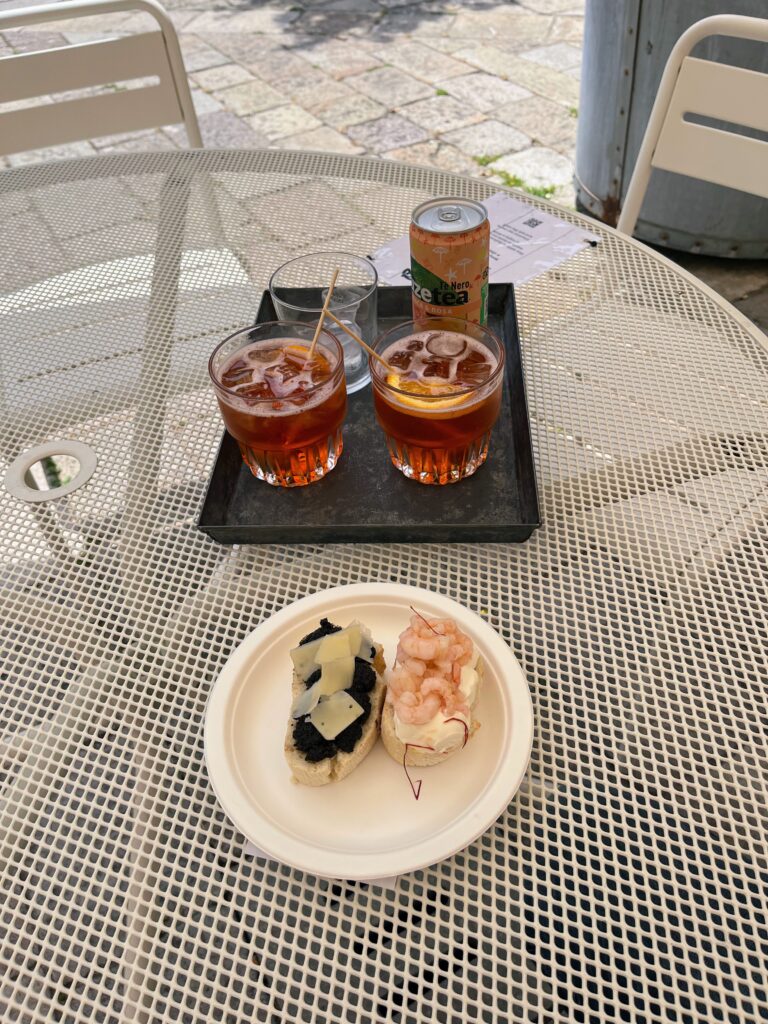
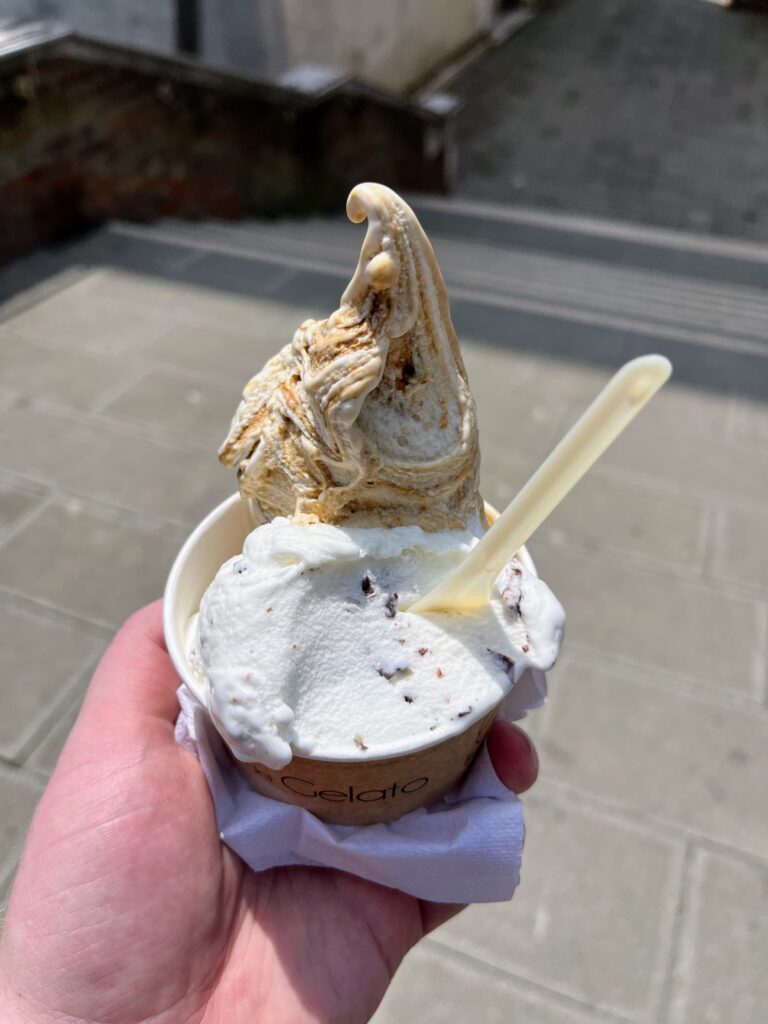
3pm – Keep Wandering, or Take a Break
Depending on the weather and your own stamina you can choose at this point to either keep wandering Cannaregio, venture further out towards Castello, or just take a break for a couple hours. The heat and humidity in Venice can certainly take their toll when you spend the whole day outside so it’s important to make sure you get plenty of water to drink and don’t overdo it with the walking. You’re here to have fun so don’t push yourself to the point where it’s not longer enjoyable in the aim of seeing everything there is to see.
6pm – Food Tour
To wrap up your first day in Venice I highly recommend taking a food tour. This is a great way to experience a wide variety of options in the city with somebody who knows all the best spots. Specifically, I recommend taking this Bacaro tour with a Venetian, available through Airbnb experiences.
I took this tour during my visit and had an absolute blast! The guide’s name is Nino and he’s a native Venetian who is able to give an incredibly authentic experience of the city. The group tour is capped at just 6 people and takes you to four different ciccheti stops. At each stop you get 1-2 different types of ciccheti as well as a glass of wine.
Nino is an incredible host, he knows so much about the city and his passion for his home and its cuisine is apparent in his work. He’s fun, knowledgeable, and easy to talk to; this was probably my favorite activity to do in Venice. It’s well worth the money.
As a bonus, my group really connected with each other and decided to share a family-style pasta meal together at the last stop after we finished the tour.

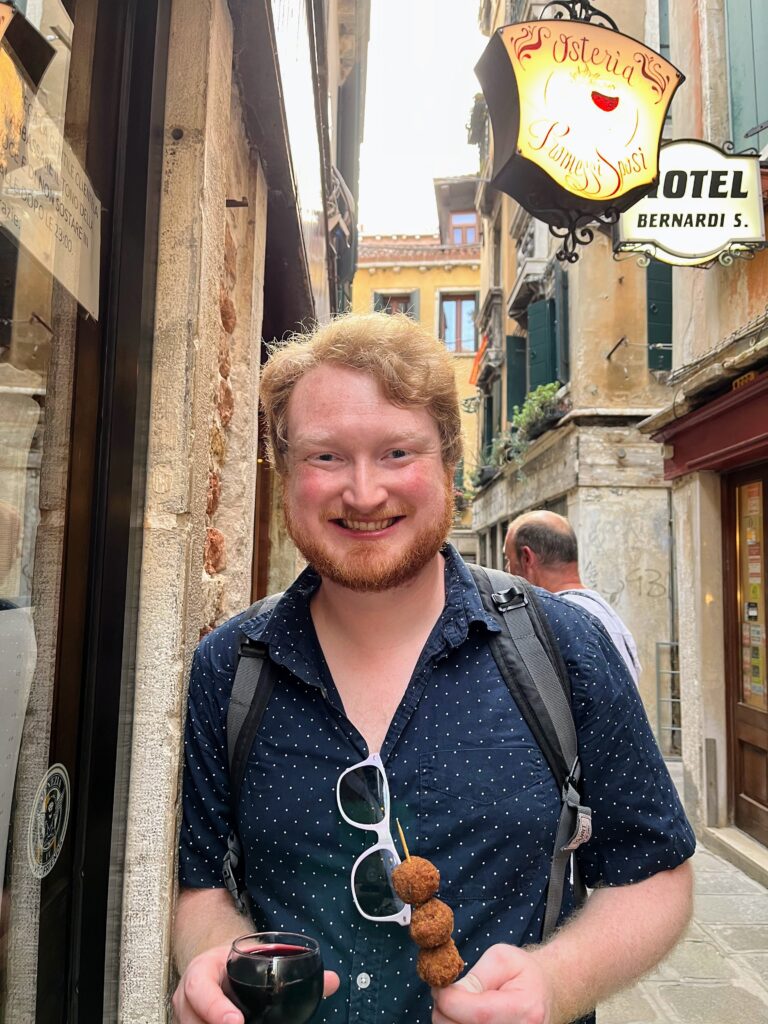
I cannot emphasize enough how much I enjoyed this tour. I tried foods I wouldn’t have thought to try otherwise and really enjoyed them, and met some great people along the way.
If Nino’s tour is booked or not available during your visit there are fortunately many other options that get great reviews from customers:
9am – Dinner (If Needed)
Since you just went on a lengthy food tour you may decide that you don’t want any dinner, but if you didn’t quite get your fill, you won’t be lacking in great dinner options.
Two great options in the Cannaregio neighborhood that I visited are Ai Promessi Sposi and Antica Adelaide.
Ai Promessi Sposi is a traditional Venetian restaurant that was recommended to my by my hotel. They have a rotating menu that consists primarily of pasta and seafood dishes. When I visited I tried the fritto misto and the vegetarian lasagna. Fritto misto is a traditional Venetian specialty of fried seafood. I enjoyed the pieces of calamari but the whole small fish weren’t really my cup of tea. The vegetarian lasagna, however, was outstanding, as was the tiramisu I had for dessert. The service was also very friendly here and the restaurant has a real local, familial feel.
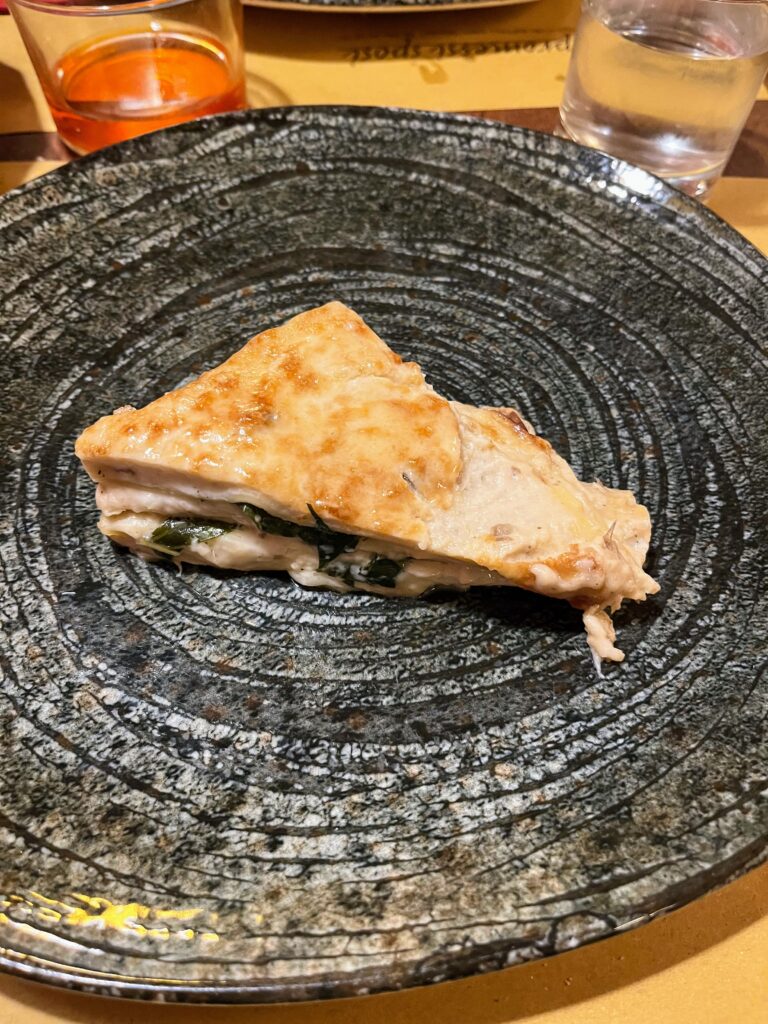
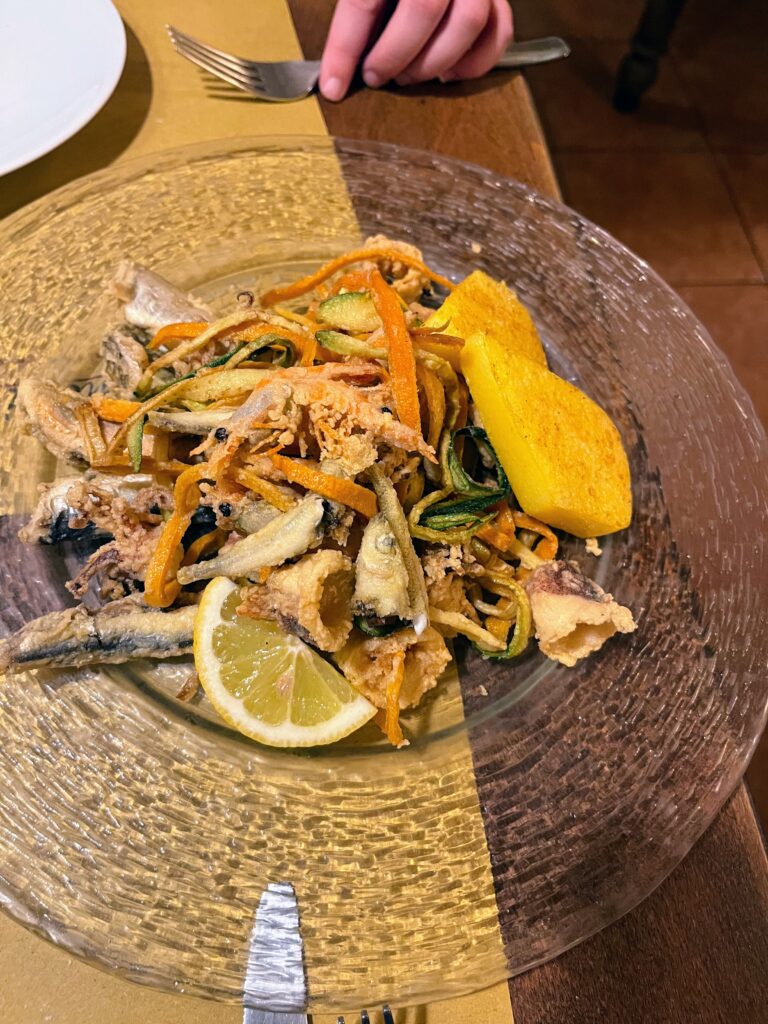
Antica Adelaide is another traditional style restaurant with both seafood and pasta options. This is where my group finished our food tour and then stayed to have dinner. Here they serve pasta family-style where the dishes are made for multiple people and shared by the table. My group ordered an Italian sausage pasta, pumpkin gnocchi, and a seafood pasta. Even though we had just eaten a lot of food on our tour, we stuffed ourselves on this pasta because it was outstanding.
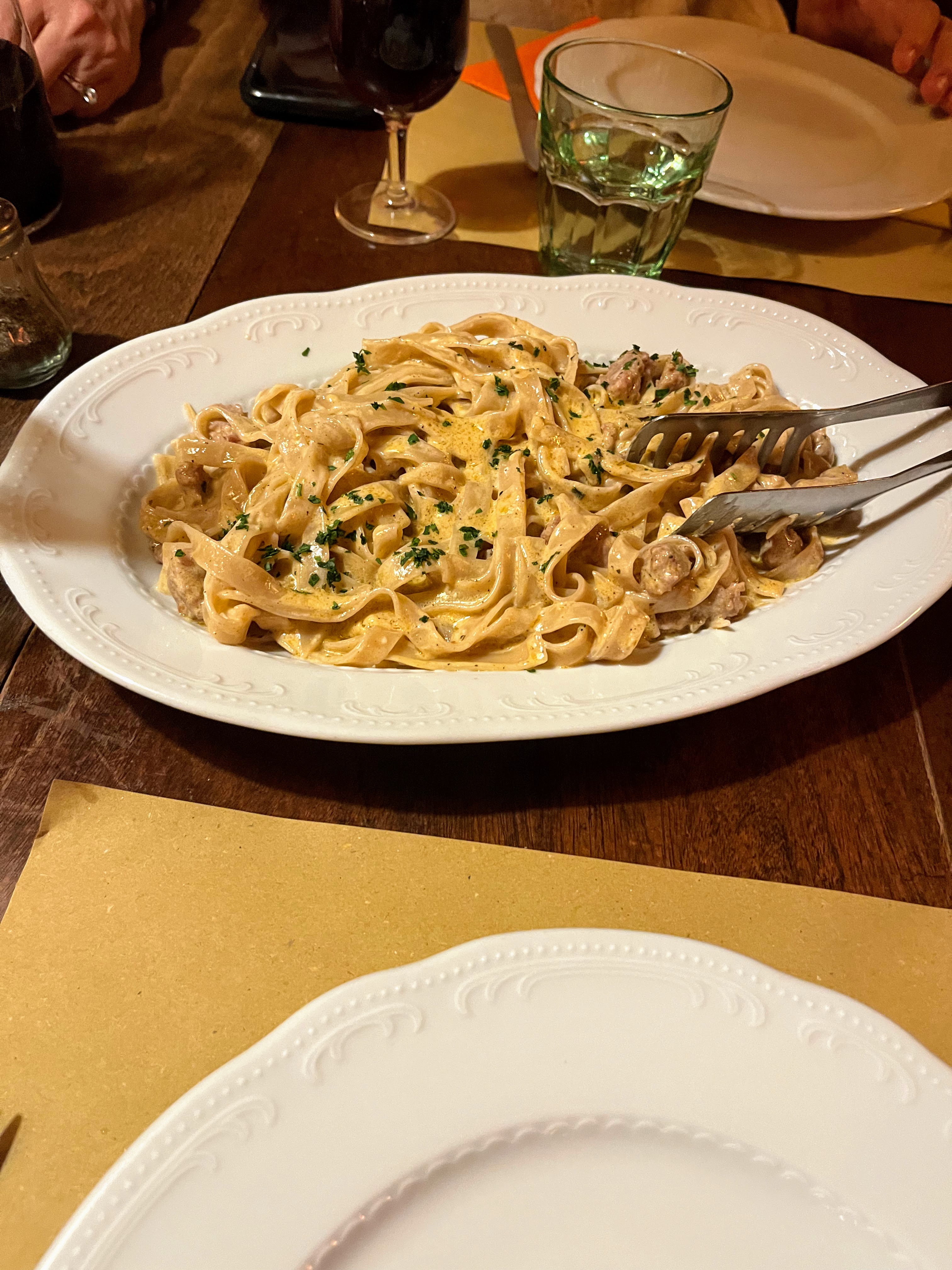
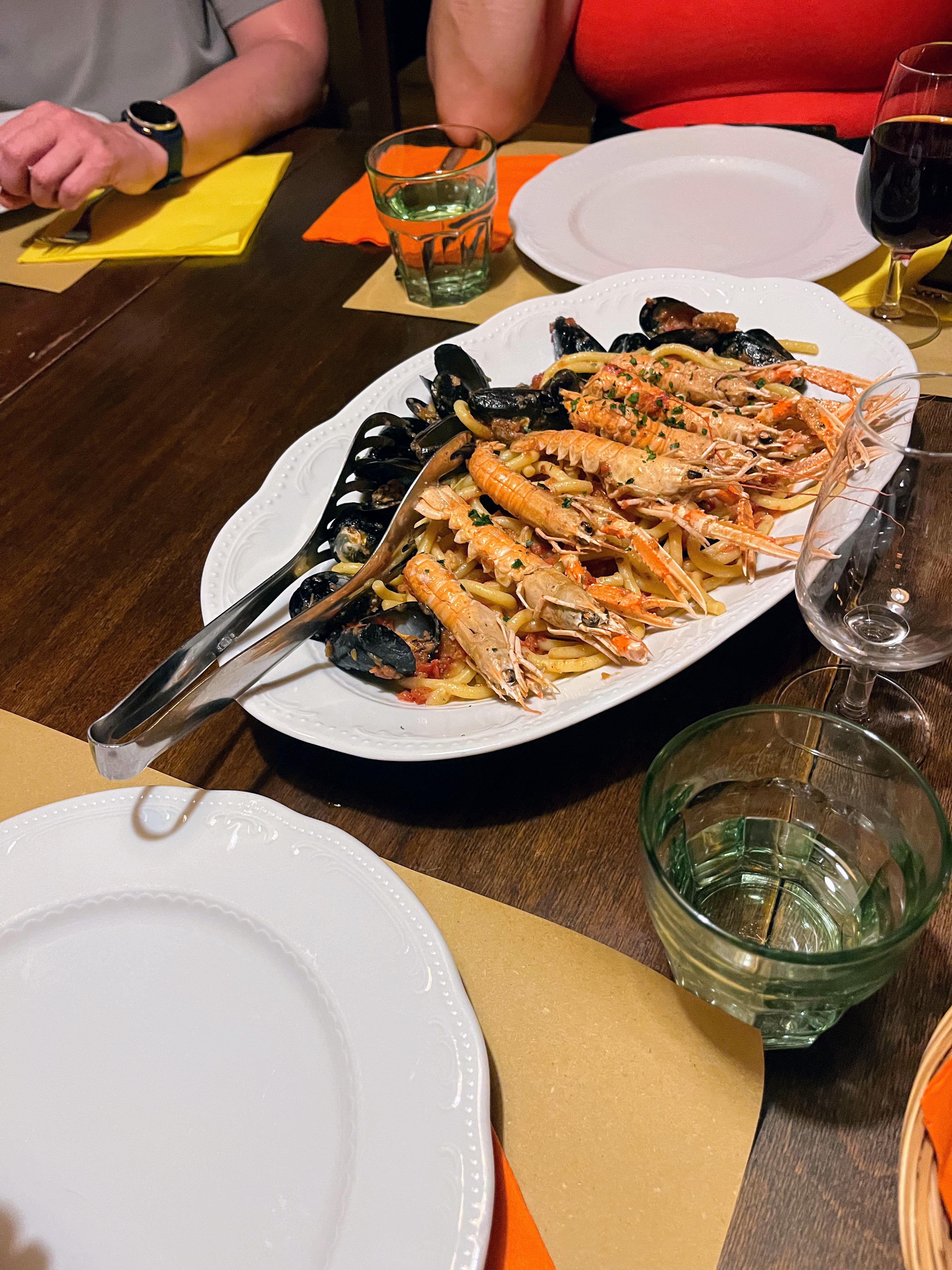
There were a bunch of other restaurants in the Cannaregio area that I had on my list, but didn’t get a chance to visit. Some of these include: La Corte 1642, Trattoria da Mimmo, Vini da Gigio, and Osteria Al Cantinon.
Day 2: Hit the Highlights
On your second of 3 days in Venice you’ll want to get up bright and early so you can catch the most popular attractions in the city before they get hit by the masses. I know people don’t always want to get up early on vacation but in this case it’s really worth it because you’ll have a much more enjoyable experience than you would if you got started a few hours later.
7:45am – Rialto Bridge & Market
The Rialto Bridge is the most famous among the hundreds of bridges in Venice, and is one of just three bridges that crosses the Grand Canal that runs through the center of the city.
The bridge here was first constructed in 1173 as a pontoon bridge, and the current stone bridge was completed in 1591. Until 1854 this was actually the only way to cross the Grand Canal on foot.
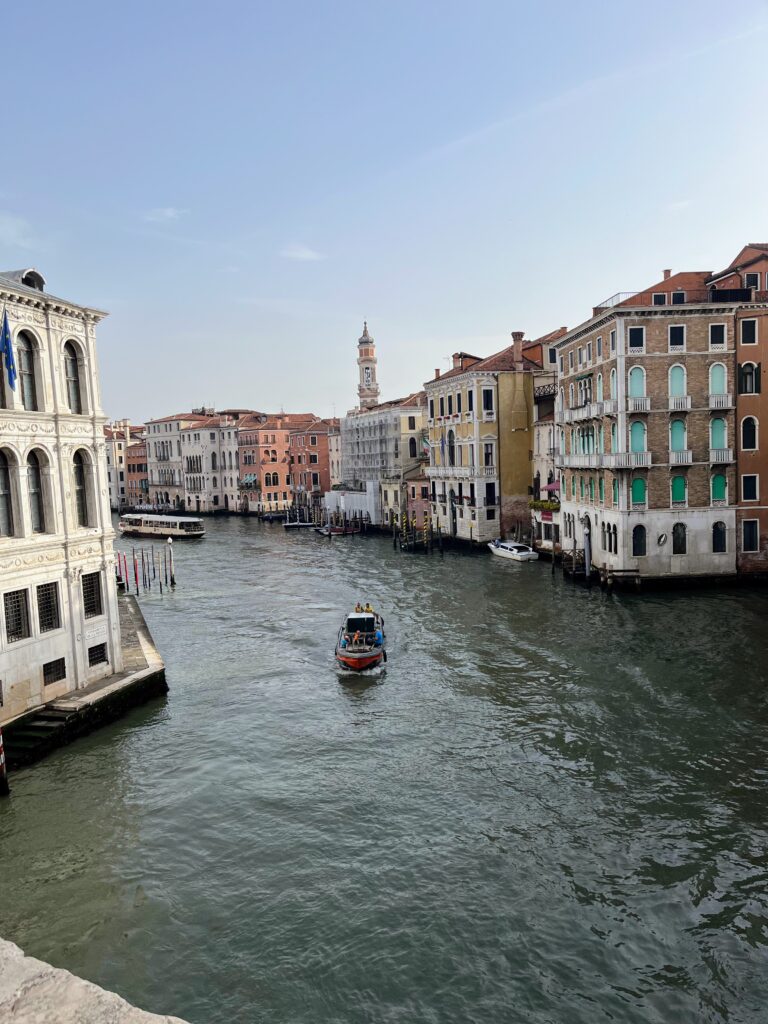
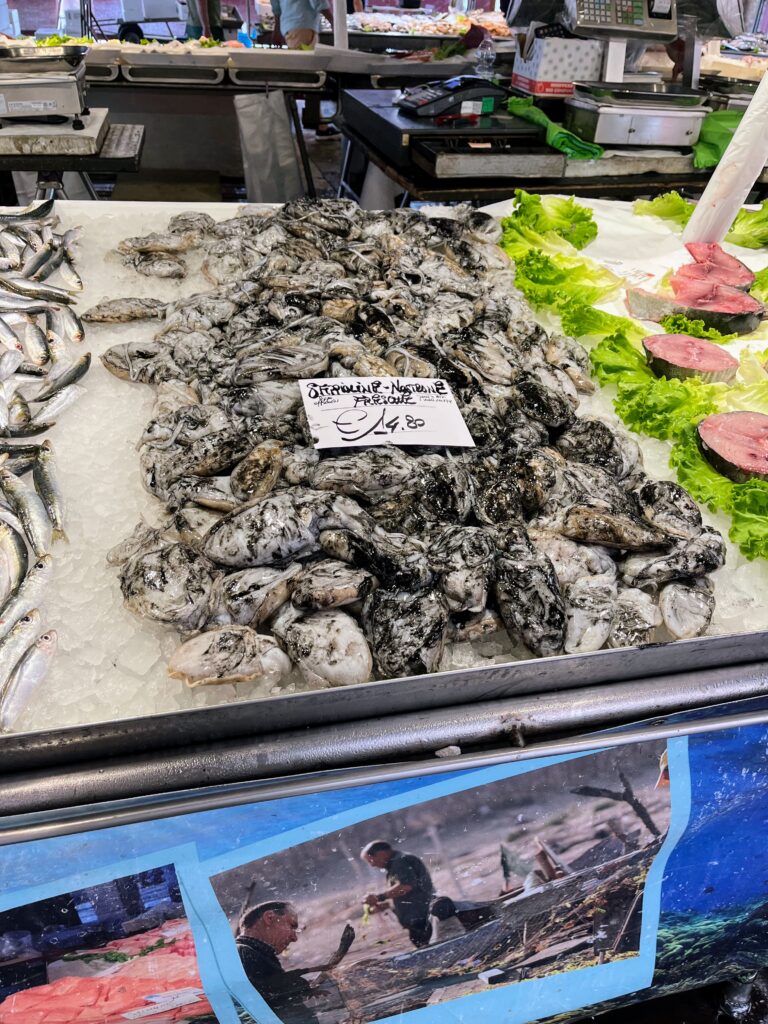
On the San Polo side of the Rialto Bridge is the historic Rialto Market. This market has been around since 1097 and is one of the most important trading centers in the city. The fish market is particularly interesting to peruse even if you don’t have an intent to purchase anything. The market is open daily except Sundays and the best time to visit is between 7:30am – 9:30am.
8:30am – Breakfast
You’ve got a busy day ahead of you so you’ll want to grab a coffee and a bite to eat before you continue. Today, I recommend you head to Pasticceria Marchini Time. This cafe and bakery is a short walk from the famous San Marco square where you’ll be heading next.
Pasticceria Marchini Time provides a typical Italian breakfast with excellent coffee and sweet pastries which are consumed at the standing bar. As a little bonus, they also serve fresh squeezed orange juice which is delicious and refreshing.
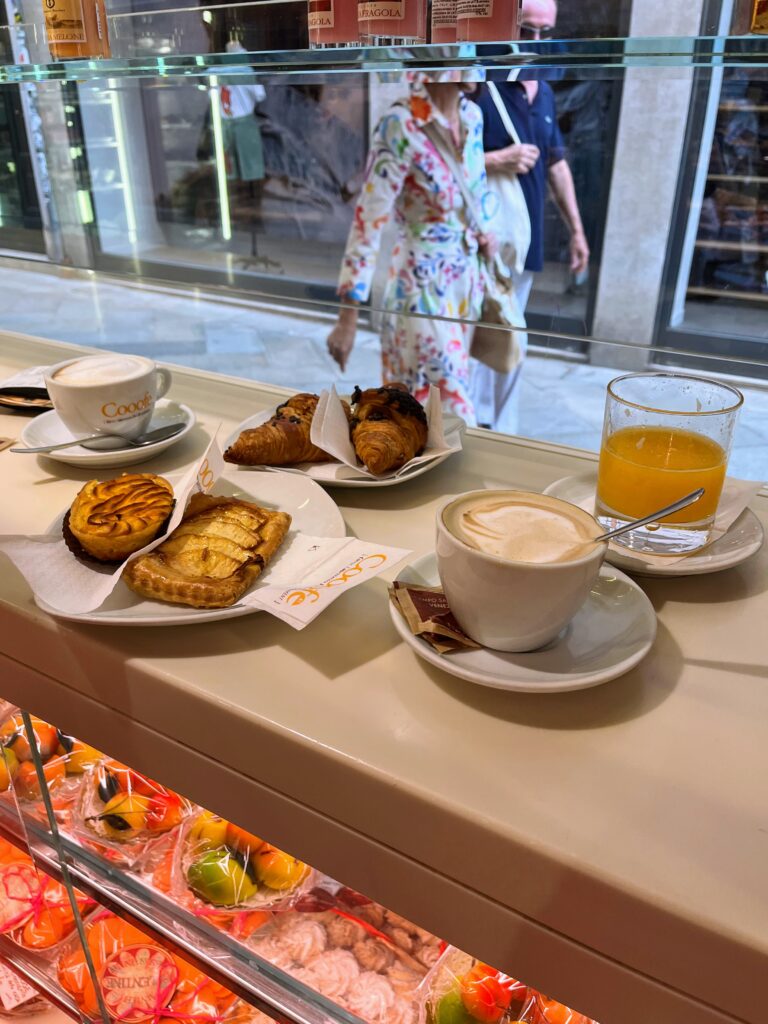

9am – Doge’s Palace
The Doge’s Palace is one of the two main landmarks in Venice’s San Marco Square. It was the residence of the Doge of Venice, who was the ruler of the Republic when Venice existed as a sovereign city-state. It was first built in 1340, but was extended over the course of the following centuries, eventually becoming a museum in 1923.
The palace opens at 9am and you’ll want to purchase your tickets ahead of time so that you can enter right at the opening time. Tickets are available online directly from the palace or via GetYourGuide. Tickets cost €25 through the palace if bought at least 30 days in advance and €30 if bought within 30 days of your visit. If you buy through the palace you’ll also gain access to a few other museums nearby, although I didn’t end up visiting any of them. Via GetYourGuide you can expect to pay about $32 and can buy those tickets at any time as long as they aren’t sold out.
Inside that palace you’ll be treated to a glimpse of the splendor that made Venice so famous at the height of its power. There is a wide array of art, from paintings, to ceiling frescoes, to statues.
Additionally, you’ll have the opportunity to walk the famous Bridge of Sighs. This bridge connected the prison to the courtrooms in the palace. It earned its name by providing prisoners with one last view over the Venetian canals before they were taken down to their cells. It was said that you could here the sighs of the prisoners as they took in this view.
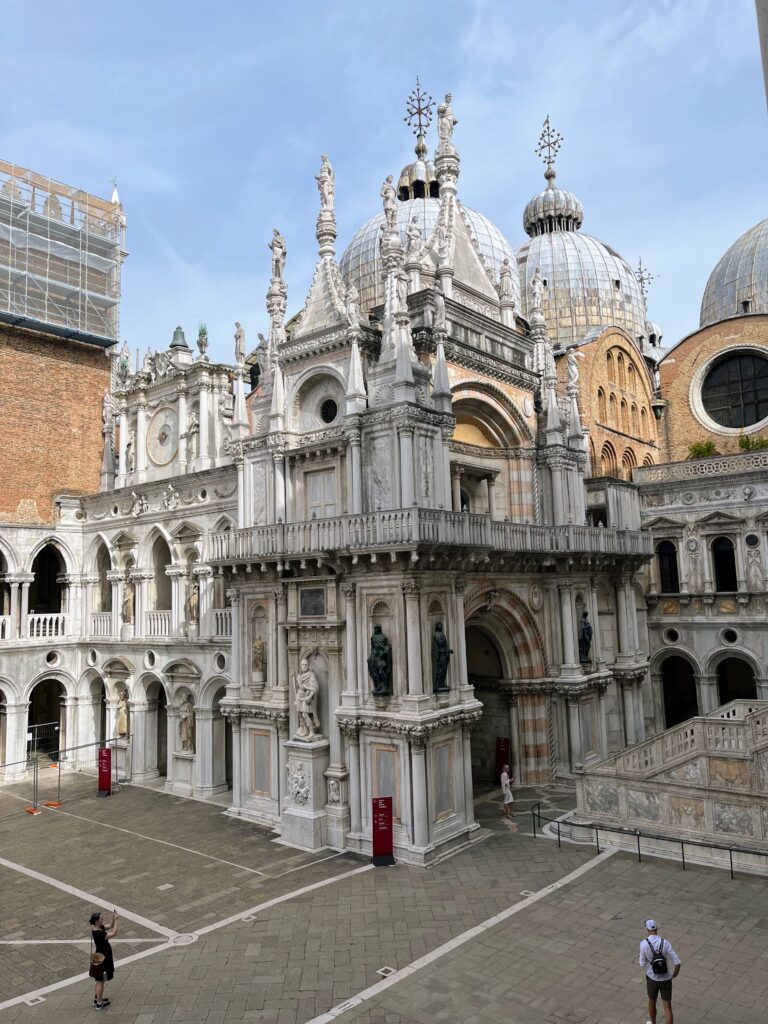
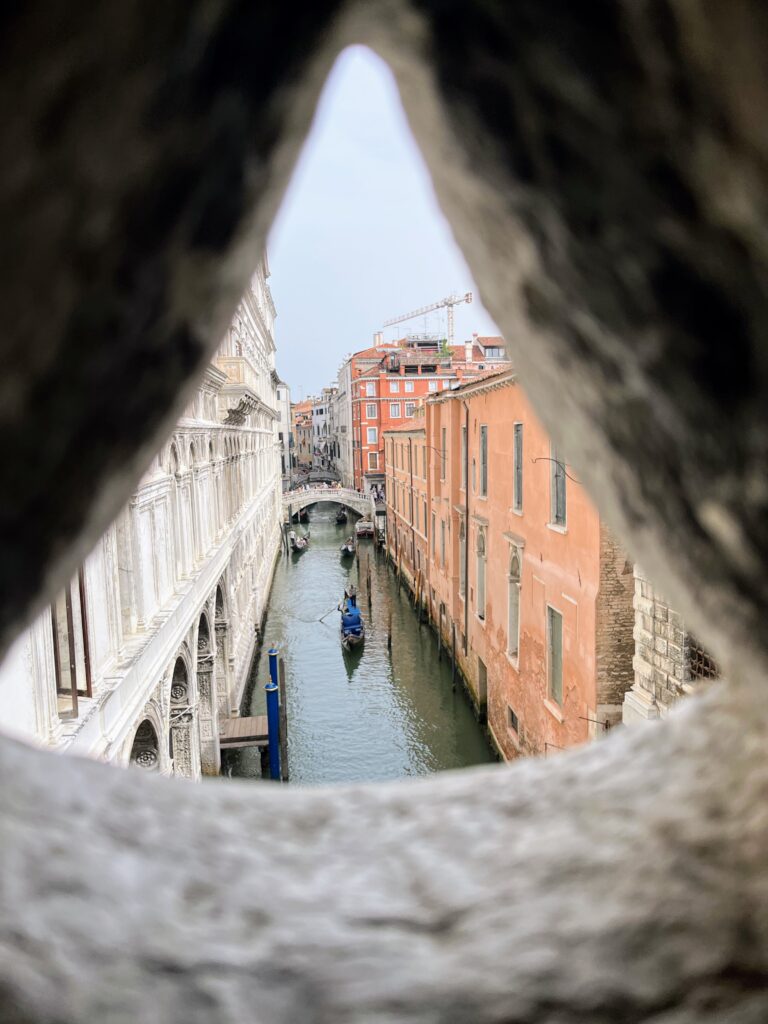
11am – Basilica San Marco
This is the other main landmark of the city. St. Mark’s Basilica is the cathedral church of Venice; it is dedicated to and hold the relics of St. Mark the Evangelist, who is the patron saint of the city. Construction on this church began around 1063.
The basilica is open daily 9:30am to 5:15pm and tickets to enter are just €3. However, the line can get incredibly long so if you want to maximize your time you’ll need to buy a skip-the-line ticket. You can buy this ticket for ~$17 per person from GetYourGuide.
Note that when you get this ticket you’ll need to go pick it up in person at Venice Tours Srl. There, they will scan the QR code from GetYourGuide and print your basilica tickets. You’ll also get access to an audio guide and receive a complementary guide book.
With this ticket you’ll be able to skip the long lines and get into a shorter queue to enter the basilica. Once inside you can use the audio guide to learn all about the basilica.
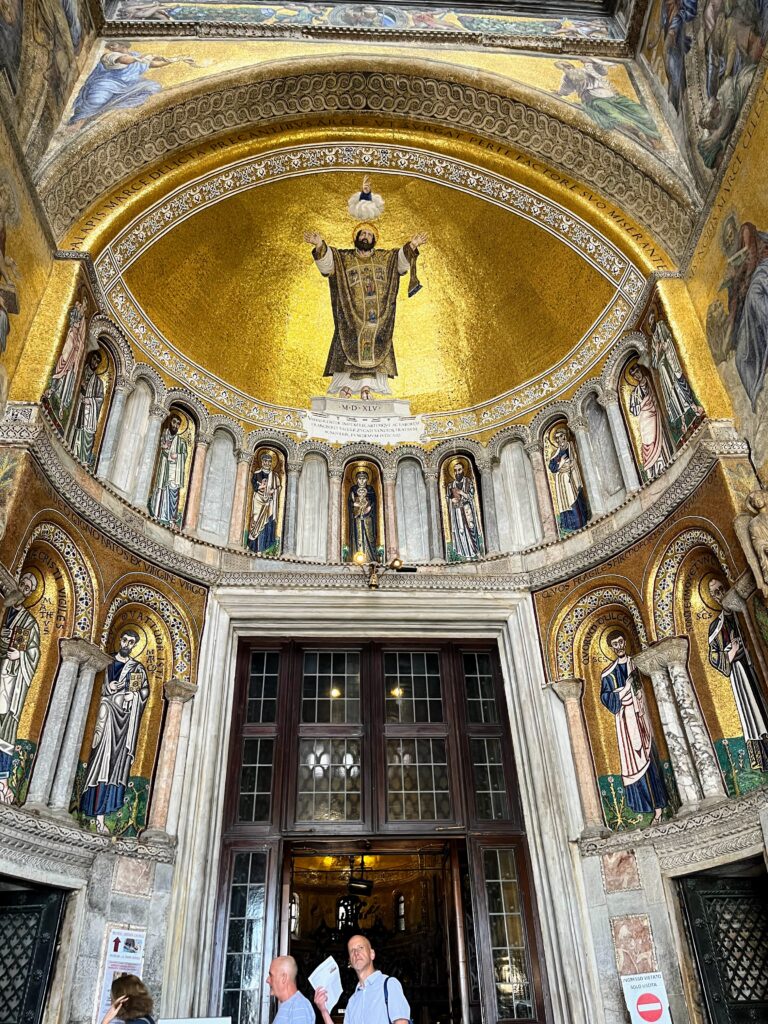

The interior of the basilica is absolutely incredible, it’s lavishly decorated and truly impressive. Unfortunately, it is quite crowded so make sure you’re aware of that going in. Unlike some other churches you can’t really sit down anywhere to rest and take it in, you’ll mostly need to keep moving along with the crowd.
Also note that you need to be appropriately dressed in order to enter the church. In general, this means no shorts or hats and your shoulders need to be covered.
If you want to try and catch both the Basilica and Doge’s Palace right at opening, you could sacrifice some sleep and do one of them on your first day in Venice.
12:30pm – Lunch
At this point you’ve checked off the biggest things there are to see in Venice, but there’s still a few more places to get to today, so you’ll need to fuel up with some lunch.
A great option for lunch is Puppa Bar Venezia. This little restaurant is located on a side street in Cannaregio and offers a great value fixed-price lunch menu. The menu includes a main course, drink, and post-meal coffee for either €15 or €18 depending on which main you order. They have a variety of pasta dishes as well as pizzas, salads, and burgers. I recommend trying out the famous Venetian specialty Spaghetti A Nero Di Seppia, or squad ink pasta. While getting a plate of black pasta may be a little intimidating, the flavor isn’t super strong and is instead a pleasant salty, seafood flavor.
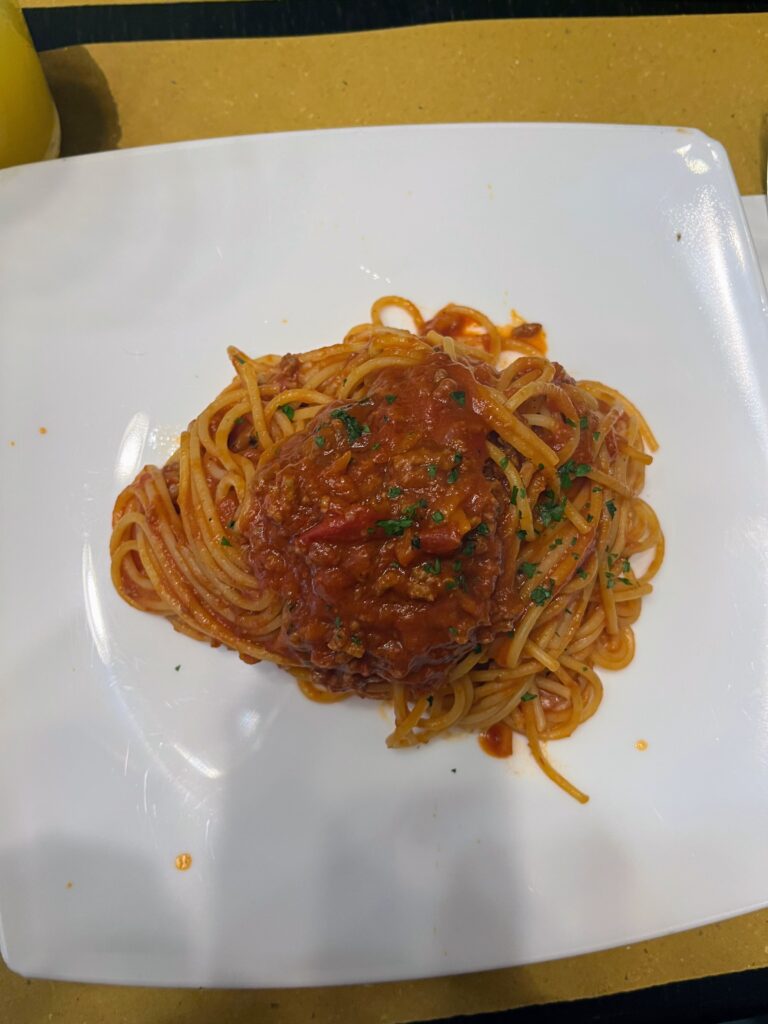

Some other options worth considering are: Osteria Alla Staffa, Rossopomodoro, and Osteria Al Portego.
1:45pm – Basilica dei Santi Giovanni e Paolo
This gothic church is a little off the beaten path, but it’s worth a stop. I probably wouldn’t have come here, but Nino, my guide from the food tour, recommended it. There’s a lot of artwork inside as well as places to read about the history of the church. It wasn’t crowded at all so you can take your time to enjoy and appreciate the building.
The entry fee for the church was just €3 which you pay upon entering. It’s open daily 9am – 6pm, except Sundays when it doesn’t open until noon.
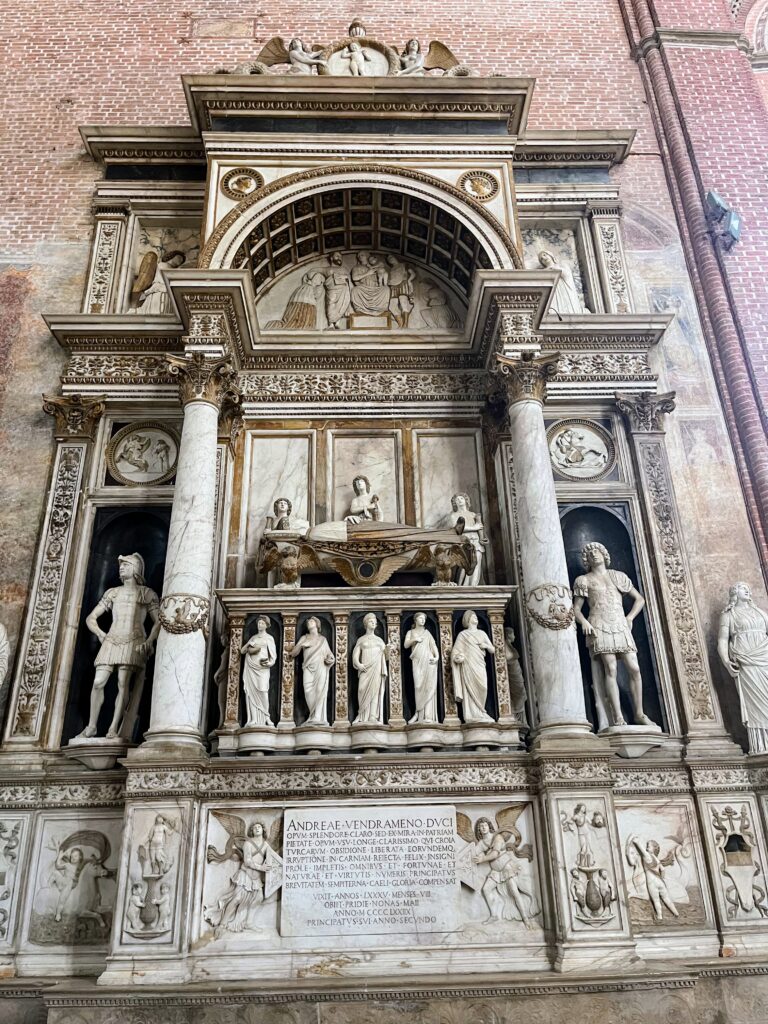
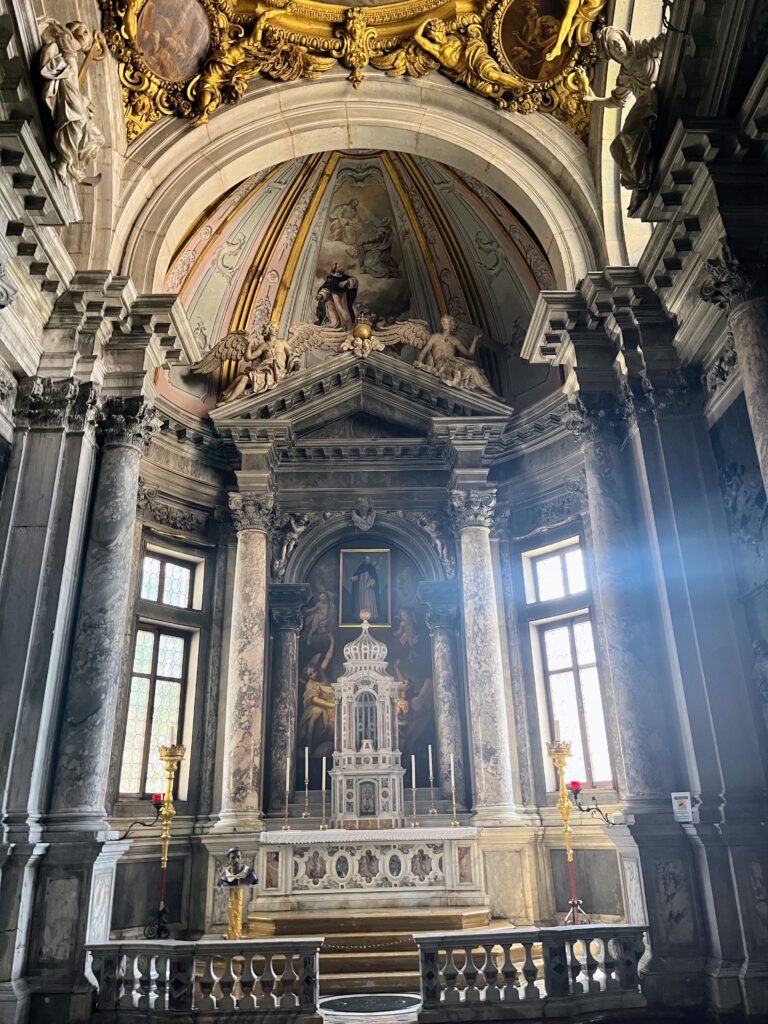
3pm – Librerie Acqua Alta
The Librerie Acqua Alta is the self-proclaimed “most beautiful bookstore in the world” and it might just be good value for that title. It is certainly one of the most unique bookstores you’ll ever come across.
Due to the frequent flooding that occurs in Venice, the books are placed in all sorts of different vestibules in an attempt to protect them. There are books in bathtubs, bins, and even boats. And with the books that have been destroyed by water damage, they’ve create a sort of staircase in the back of the store.
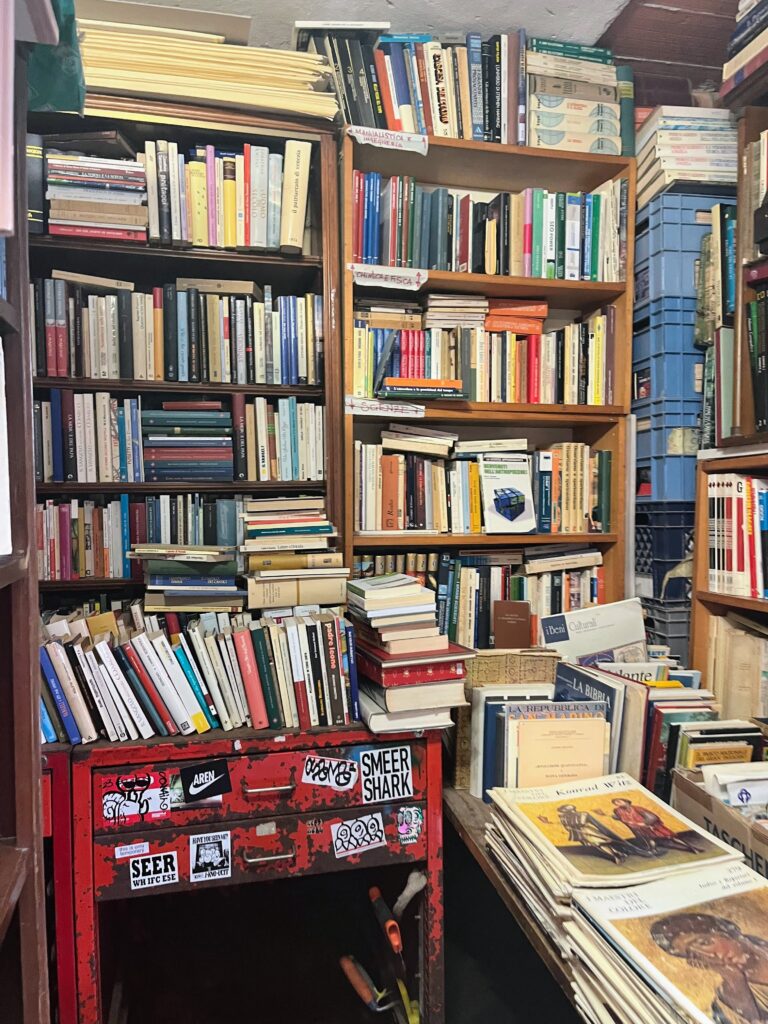

The bookstore is open daily 9am – 7:15pm. You don’t need to pay to go in, but there is a selection of English-language books if you’re interested in taking home a souvenir!
4pm – Palazzo Contarini del Bovolo
This small palace is famous for its striking external multi-arch spiral staircase. The palace was built in the 15th century as the residence of the Contarini family. The 1952 film adaptation of Shakespear’s Othello was partially filmed here, with the staircase being prominently featured. Despite being near other major tourist attractions, this palace is not on every tourist’s radar.
In addition to admiring the architectural beauty of the palace and particularly the staircase, you can also climb to the top of the stairs to get a great view over the city.
You definitely need to get tickets in advance as they are on a timed entry system and only 10 people are able to visit every half hour, and visits are capped at 30 minutes. Tickets can be purchased online for €8 per person via the palace’s website or GetYourGuide.
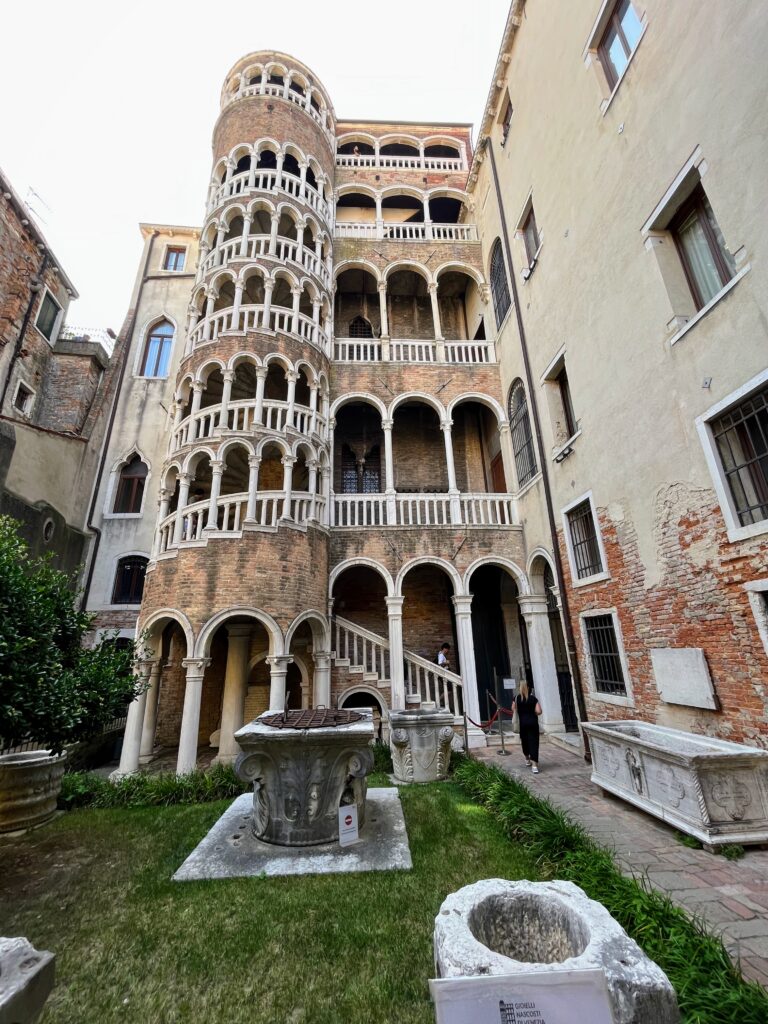

4:45pm – Chiesa di San Zaccario
Chiesa di San Zaccaria is a 15th century monastic church dedicated to St. Zechariah, the father of John the Baptist. The original church on this site was built in the early 9th century. That church was replaced by a gothic church in the 15th century, which was replaced by the church we see today that was built between 1458 and 1515.
San Zaccaria is open daily 10am – 12pm and 4pm – 6pm, except Sundays when it is only open 4pm – 6pm. The church is free to visit.
The church is beautifully decorated with some particularly noteworthy ceiling frescos.
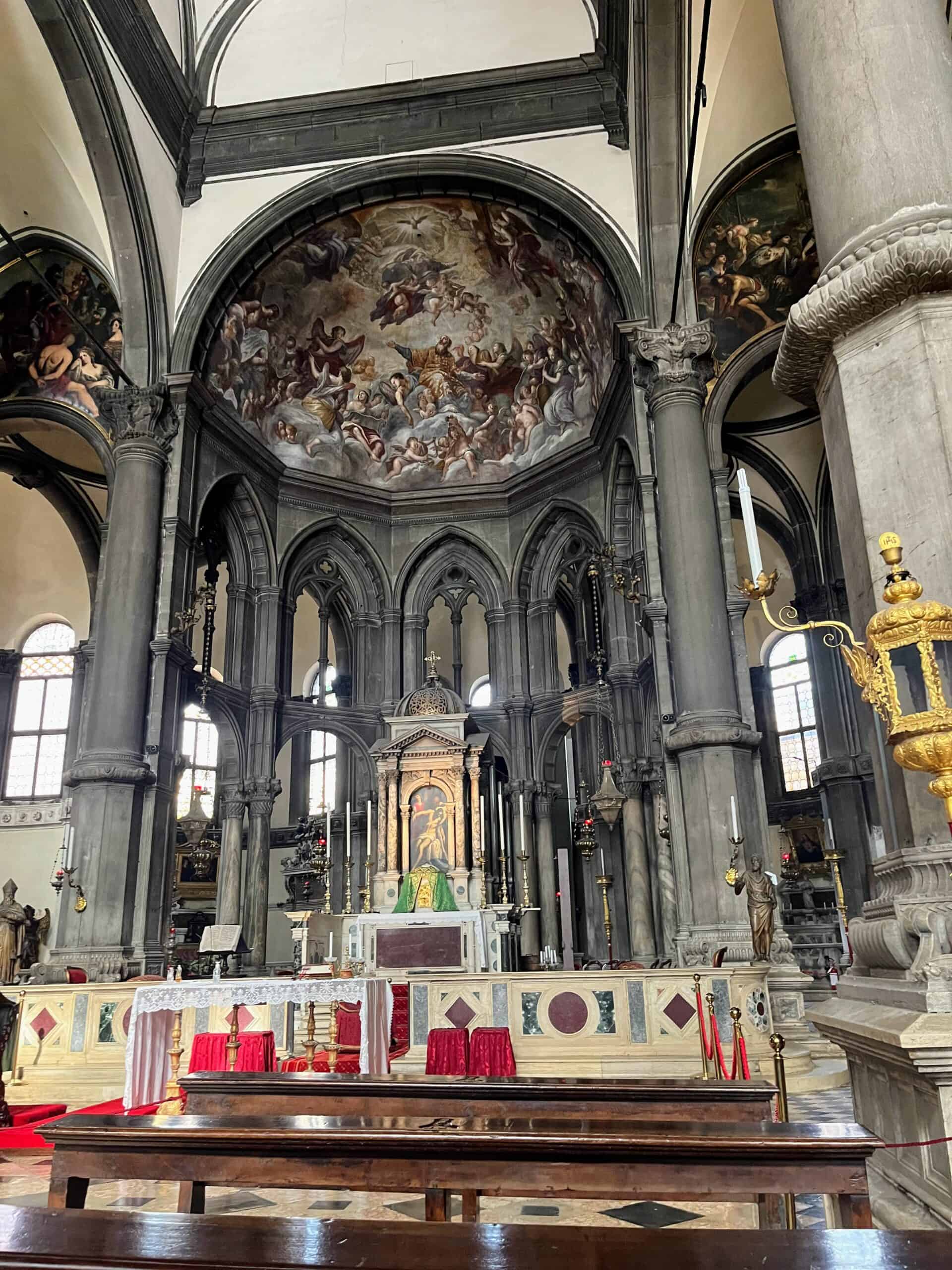
5:15pm – Gondola Ride (Optional)
I’ll be completely honest and say, in my opinion, gondola rides are not worth the money. That being said, I don’t regret doing it and certainly don’t judge others for doing it. Why? Because, despite the cost, it is an iconic and unique thing to do in Venice and, ultimately, it is fun. It’s absolutely worth doing if you’re not on a tight budget, just be aware going in that it’s not great value for the money.
The standard price for gondolas is around €80 for a 20-30 minute ride. The price is by ride regardless of how many people are on the boat, so you can make it cheaper by riding with other people. The boats can hold a max of four passengers.
When walking around Venice you’ll see signs indicating where gondolas depart from so you can find one that’s convenient for you and wait until the gondolier returns.
Also note that there’s no need to tip your gondolier as that’s factored into the price.
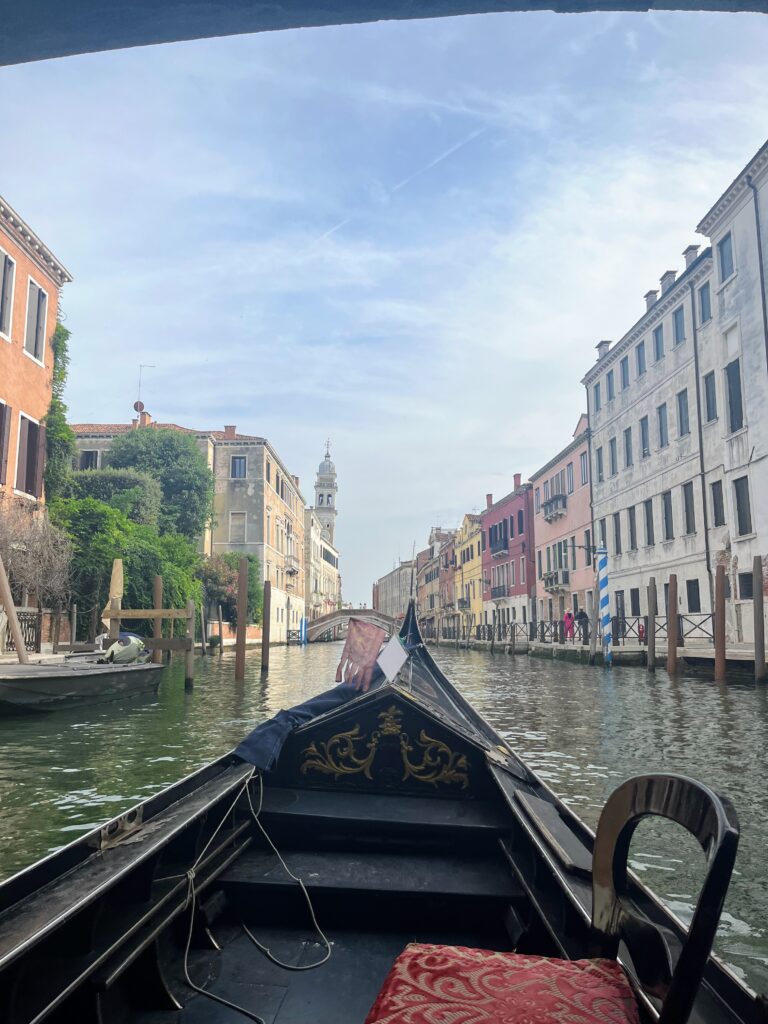
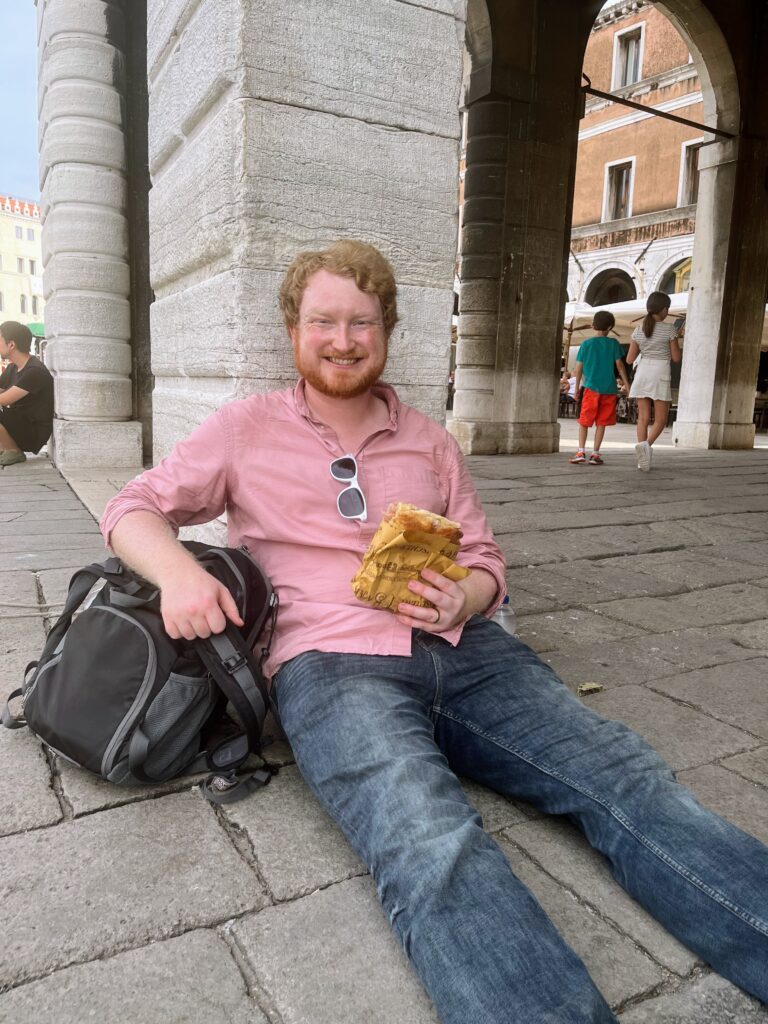
6pm – Dinner
At this point it’s been a long and busy day, it’s time to wrap things up with some more food before heading back to the hotel to decompress. If you’re looking for something a little on the casual side I recommend grabbing a sandwich at l’Bacaro de’ Bischeri.
l’Bacaro de’ Bischeri is a small sandwich shop located near the San Polo end of the Rialto Bridge, in between the bridge and the Rialto Market. They have about 10 sandwich options that all cost about €7-8. The food here is excellent, and the sandwiches are a good size for the price. There’s no seating in the restaurant, but you can take a quick walk to find yourself somewhere to sit along the canal to get some great views while you enjoy your meal.
A few other restaurants in the area worth checking out are: Antico Forno, Bar All’Arco, Cantina Do Mori, and Osteria Bancogiro.
7pm – Gelato
A day in Italy simply wouldn’t be complete without a bit of gelato. For that, I recommend heading over the Rialto bridge to Gelateria Gallonetto. This place had the best gelato that I tried during my time in Venice so you should definitely make sure to get here at some point during your trip.
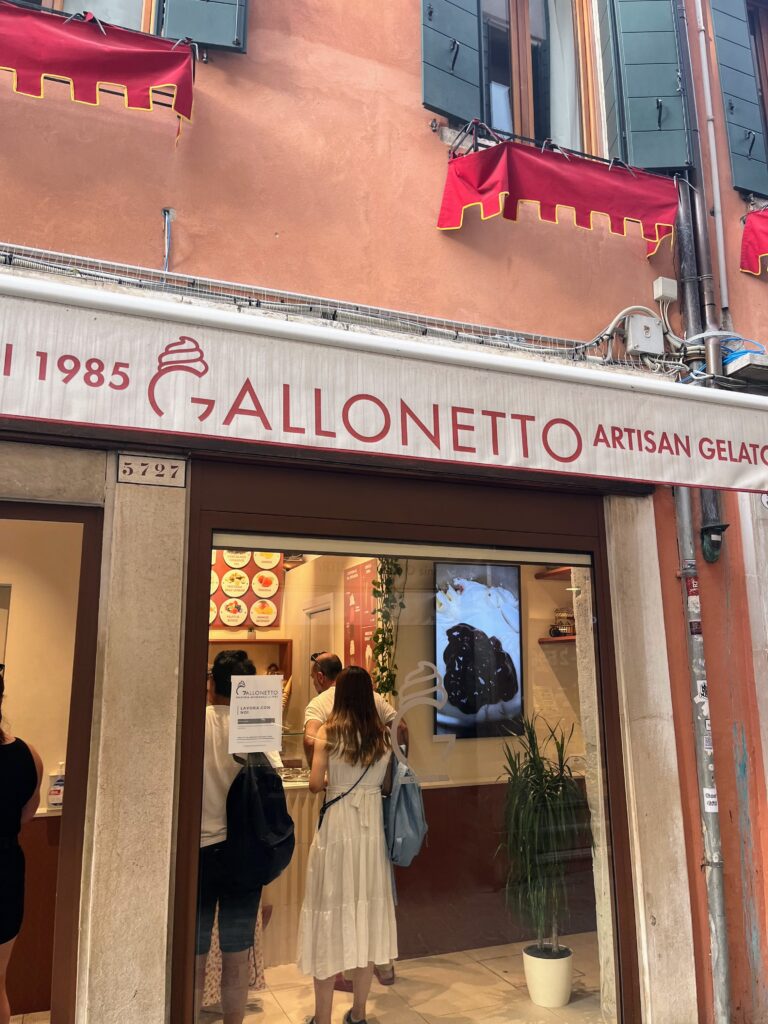
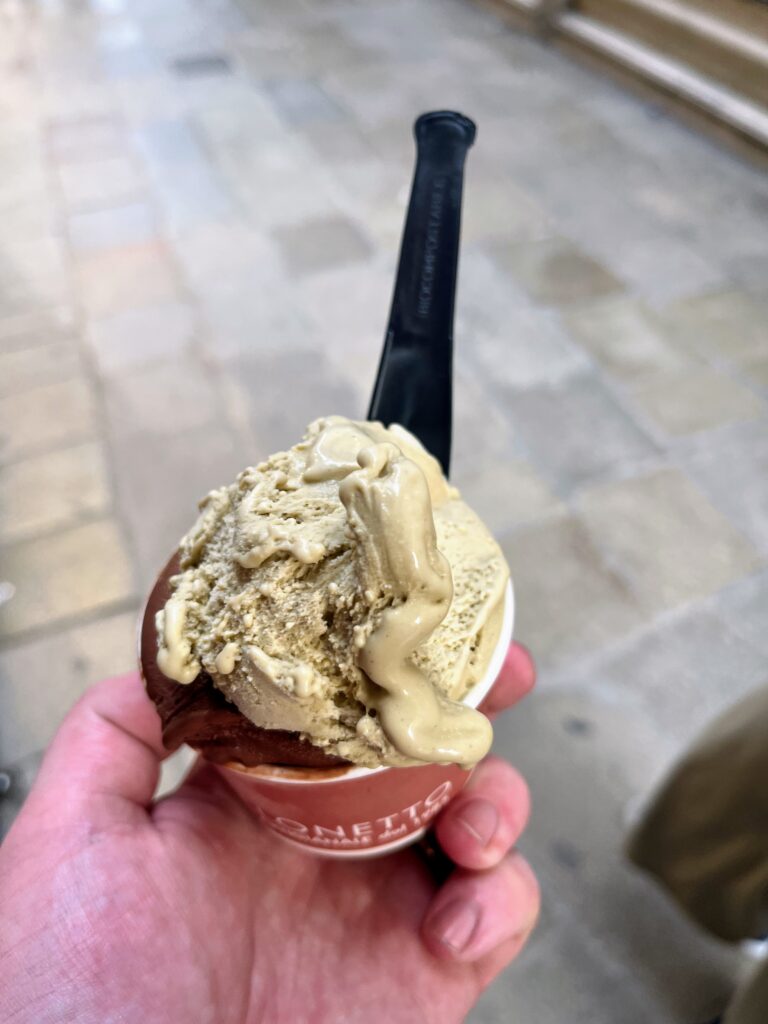
Day 3: Islands
On your last day of 3 days in Venice it’s time to get off the main island and explore a couple other ones in the lagoon: Burano and Murano. These are the two most notable and well-known islands in the lagoon (outside of Venice of course). Burano is known for its colorfully painted houses that were painted this way to help fisherman see the island in the dark. Murano is known for it’s glass making; this had to happen on another island than Venice because having the fires for glass blowing around the wooden houses in Venice presented a significant danger to the city.
Today we’ll start by heading to Burano, which is the further of the two from Venice. By getting here early you’ll be able to avoid the crowds that can accrue later in the day, allowing you plenty of time to take all the photos you want on this beautiful island.
8am – Arrive at F.te Nove “A” Vaporetto Station
To get to Burano and Murano you’ll need to take the #12 Vaporettto, which departs from F.te Nove “A” station on the northern end of the island. The boat leaves twice every hour at minutes 10 and 40, I recommend getting to the station a little early to make sure you don’t need to rush.
You’ll be taking 3 vaporetto rides in total today, which means that you should buy a daily pass online from Venice’s tourism site. The pass costs €25 per person and is good for 24 hours. Single rides cost €9.50 so if you’re going to take more than two in a day it’s worth it to buy the day pass.
The vaporetto leaves at 8:10; Burano is the furthest stop on the line so I’d recommend getting a seat if you can because it is about a 40-45 minute journey.

9am – Burano
Burano is a small island so you can easily walk most of it in an hour or two, which is what I recommend you do. There’s not a lot of specific attractions here, instead the real draw is the aesthetic of the island itself. Take time to enjoy and appreciate the beauty of the place. The colorful houses are fun and whimsical and if you get here before the crowds it is a really enjoyable place to just be.
11:20am – Vaporetto to Murano
Make your way back to the vaporetto stop to catch the 11:20 boat back towards Venice. This time, get off at the Murano stop, which is about 30 minutes from Burano.
12pm – Murano
Since you haven’t had a chance to get any food yet today, the first stop in Murano should be for lunch. I recommend heading to B Restaurant, a traditional Venetian place not far from where the vaporetto drops you off. I had the seafood risotto and it was excellent!
Once you’ve filled up, it’s time to explore the island. As with Burano, my recommendation here is to just wander around and enjoy the ambiance of the place. It has a lot of the same charm of Venice but generally less crowds.
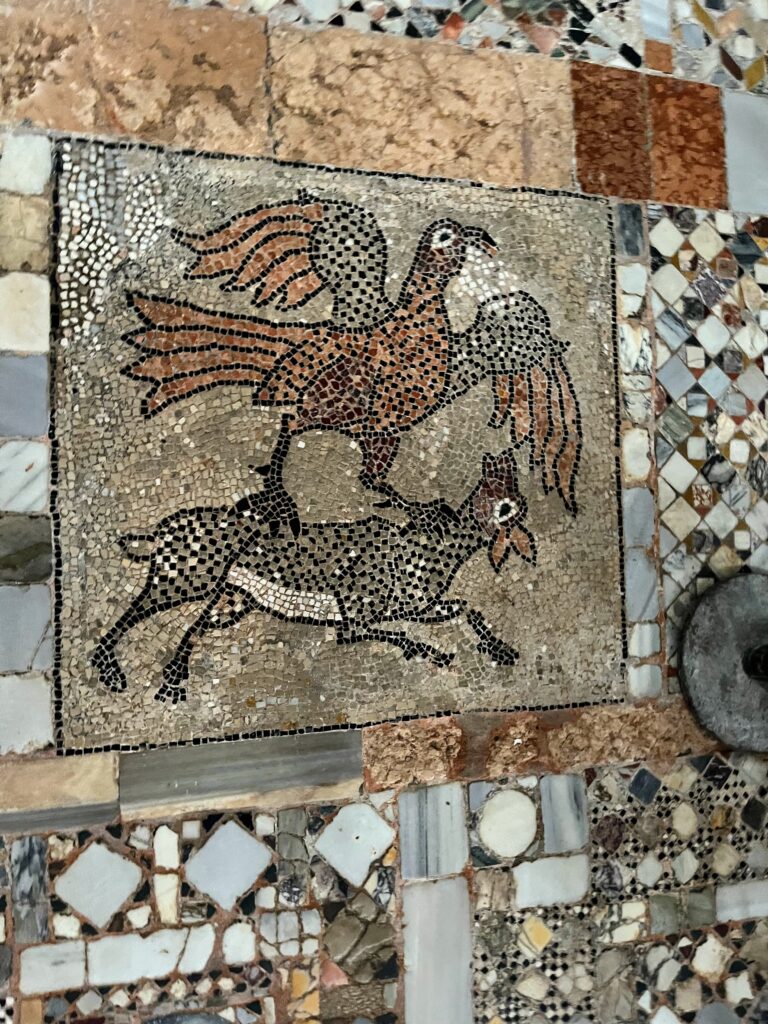

One place to make sure you get to is the Basilica dei Santi Maria e Donato. This church has origins dating back to the 10th century and is a really cool stop in Murano. In particular, the floor mosaics are an interesting and unique feature of the church.
After the church, wander around the island and explore the narrow streets and enjoy yourself at whatever pace suits your fancy. If you’re into that sort of thing, the cemetery of Murano is open to the public and is nicely decorated. Alternatively, you can sign yourself up for some glass-related sightseeing. There are lots of tours available to give you a look into Murano’s famous glass blowing industry.
If you’re looking for a snack break, I got some good gelato at Murano Gelateria Artigianale.
4pm (or whenever) – Vaporetto to Venice
Whenever you’ve gotten your fill of Murano, catch the vaporetto once more to get back to Venice proper. Make sure that you get on the boat going towards F.te Nova, this is the first departure of the day where there are boats departing in both directions so make sure you get on the right one!
5pm – Free Time & Dinner
With the rest of your day you can just relax, whatever that means for you. That could be lounging at your hotel, finding a bench to sit on, wandering the streets some more, or grabbing a coffee.
At some point in the evening you’ll need to get some dinner. If you’re looking for a quick bite after a long day full of walking, I recommend trying Fried Land.
Fried Land is a hole in the wall kind of place with a variety of fried seafood and traditional pasta dishes. Prices are really cheap and the pasta is tasty and the portion size is enough for a full meal. Pasta prices range from €7-9 making this a very budget friendly option. When I visited I had the calamari and the Spaghetti alla carbonara, both of which were great!
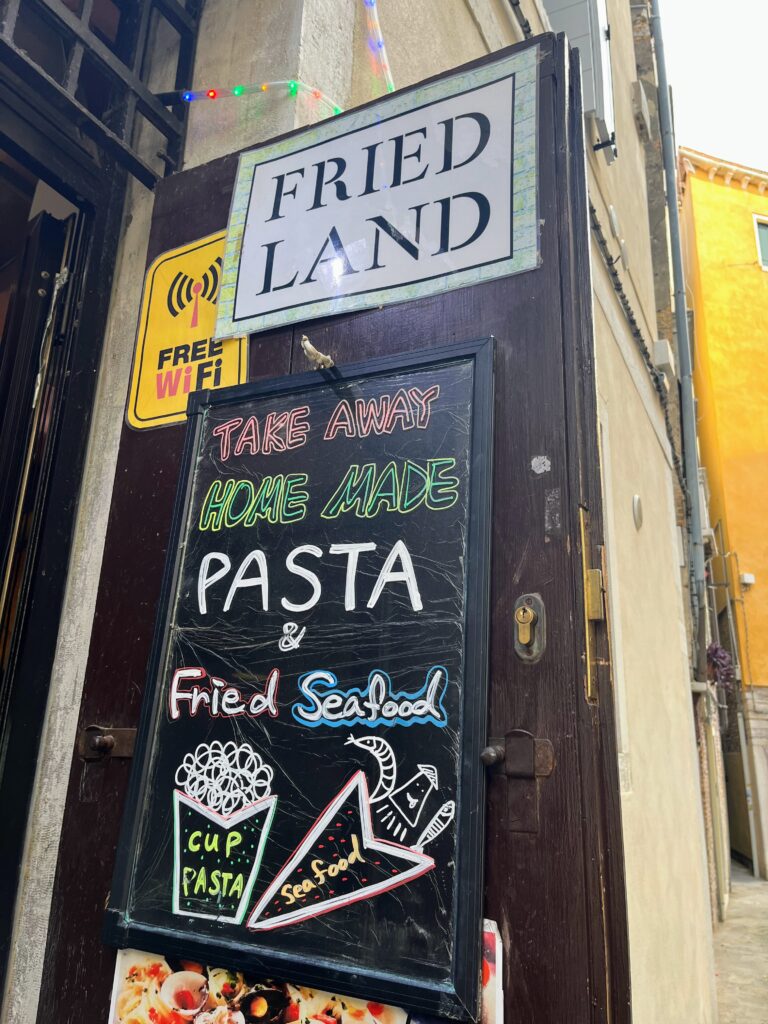

Looking for something different? Check out some of the options I talked about for the previous nights!
Other Things to Do
This itinerary covers everything that I managed to make it to over 3 days in Venice, but there’s certainly more things to see if you want to stay longer or do something different. I’ll cover some of those options below.
Basilica Santa Maria della Salute
The Salute is a minor basilica located in the Dorsoduro neighborhood of Venice. It’s located across the grand canal from the San Marco neighborhood, so most visitors will get a view of this church even if they don’t visit it. The church was build in 1631 and was dedicated to Our Lady of Health after a pledge by the city after recovering from an outbreak of the plague.
The basilica is open daily 9:30am – 12pm and 3pm – 5:30pm. Entering the church is free, but you can pay €4 to enter the sacristy and €8 to go onto the terrace which has panoramic views of the city. Tickets can be purchased ahead of time on the basilica’s website.
Regardless of where you start, there’s a good chance that the quickest route to the basilica will be to take a traghetto ferry from here to cross the grand canal. If you don’t want to take the ferry then you’ll likely need to walk a bit further and cross the Accademia bridge to get to the other side of the canal.
Ca’ Rezzonico
Ca’ Rezzonico is an art museum located on the grand canal in the Dorsoduro neighborhood. It is considered a notable example of 18th century Venetian baroque and rococo architecture. This building was used by Pope Clement XIII as his residence during the 18th century. Today, it is a three story museum containing various 18th century artifacts as well as artwork from notable Venetian artists of that time.
The museum is closed on Tuesdays but is otherwise open daily 10am – 6pm from April through October, and 10am – 5pm from November through March. Last entrance is allowed one hour prior to closing. Tickets cost €10 and can be bought online at the museum’s website. Audio guides can be purchased for an additional €4.
Ca’ Rezzonico has a vaporetto stop on the #1 vaporetto line so this is likely to be the quickest way to reach the museum, although walking is always an option if you don’t want to shell out more money for the ferry.
Gallerie dell’Accademia
The Gallerie dell’Accademia is a museum of pre-19th century artwork that was founded in 1750. It was originally the gallery of the art academy of Venice, but became independent in 1879. Despite the separation, the art academy was located in the building with the museum until the school moved in 2004.
The museum is open daily 8:15am – 7:15pm except for Mondays when it closes at 2pm. The ticketing office closes one hour prior to the museum’s closing. You can purchase tickets online directly from the museum for €15.
The gallerie is easily accessible on foot or by vaporetto. It is located in the Dorsoduro neighborhood and is at the end of the Ponte dell’Accademia, a bridge which crosses the Grand Canal. It also has its own vaporetto stop which is on the #1 and #2 ferry lines.
Giardini delle Biennale
The Giardini is a park in Venice that was created by Napoleon Bonaparte. It contains 30 pavilions which are dedicated to a particular nation and display works of art by artists from that nation. The gardens are also famous for having many cats roaming around.
The park is free to enter and is located near both the bus and train stations.
San Giorgio Maggiore Church
San Giorgio Maggiore is a 16th century church built on its own island, located across the Grand Canal from San Marco Square. The first church on this site was built around 790 but was destroyed by an earthquake in 1223. After the initial rebuild of the church, the monks noticed many flaws in the way it was built so they decided to rebuild it again in 1565, which resulted in the structure we see today.
The basilica is open Monday – Saturday from 9:30am – 12:30pm and 2:30pm – 6pm and on Sundays from 8:30am – 11am and 2:30pm – 6pm. Visitors can enter the basilica for free but must pay €6 to enter the bell tower, which provides great views over the city. The bell tower is open from 10am – 1pm and 2pm – 6pm.
To reach the church you’ll need to take the #2 vaporetto, departing from of of Piazzale Roma, San Marco, or San Zaccaria stations.
That’s a wrap on a great itinerary for spending 3 days in Venice. I hope it’s clear to you that Venice is worth so much more than just a day trip. There is so much to do here that you can’t possibly get the full experience in just a day. Venice gets a bad rep from some people, but if you do it right it is a fun and rewarding place to visit.
Book Your Trip
Flights
Use Google Flights to search for specific dates, or set up destination alerts on Going
Accomodation
Book a hostel stay at Hostelworld
Search for hotels with Booking.com or Google Maps
For more info on searching for hotels on Google Maps, check out this post
Helpful Resources
Looking for more companies that can help you plan your trip? Check out my resource page for a list of all my favorite brands that I use when planning my own travels.
Disclosure: Note that some of the links in this article may be affiliate links. At no additional cost to you, these links allow me to earn a commission if you make a purchase. I will only recommend products and companies I actually use and the income I earn helps me to keep this site up and running.


